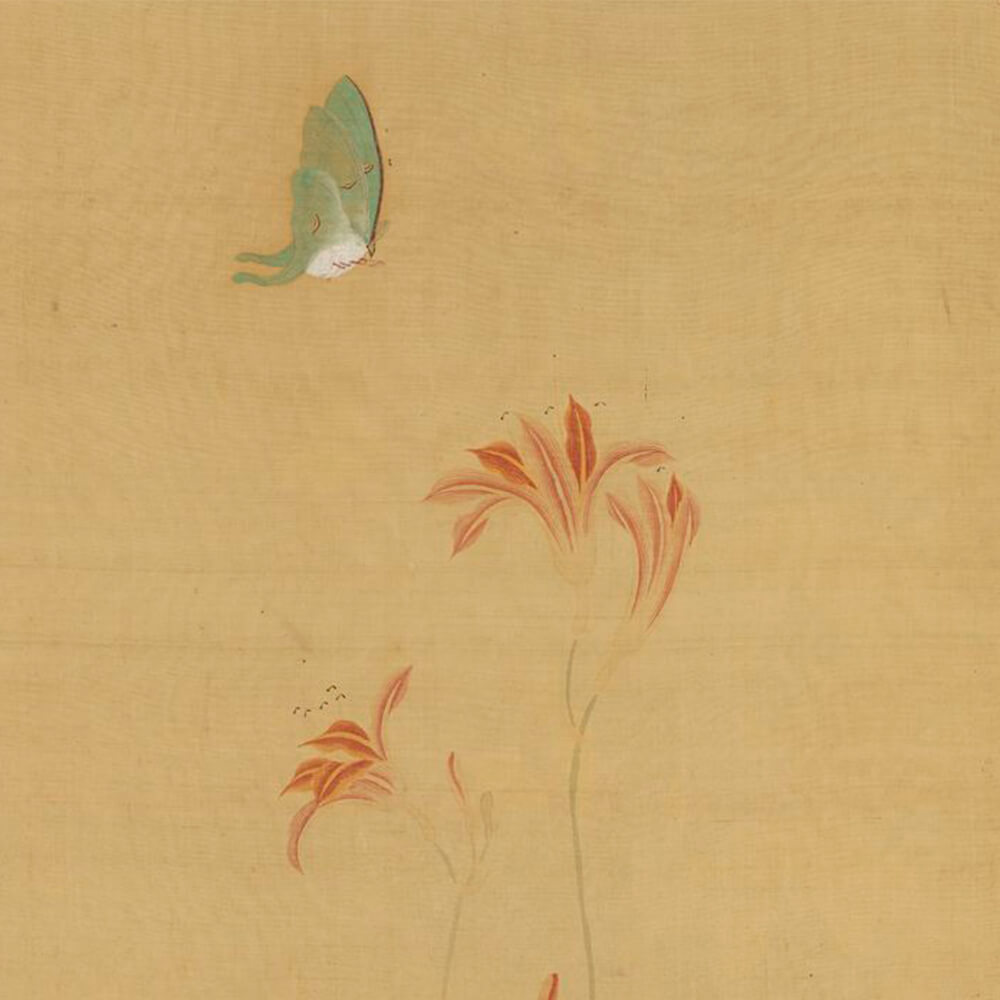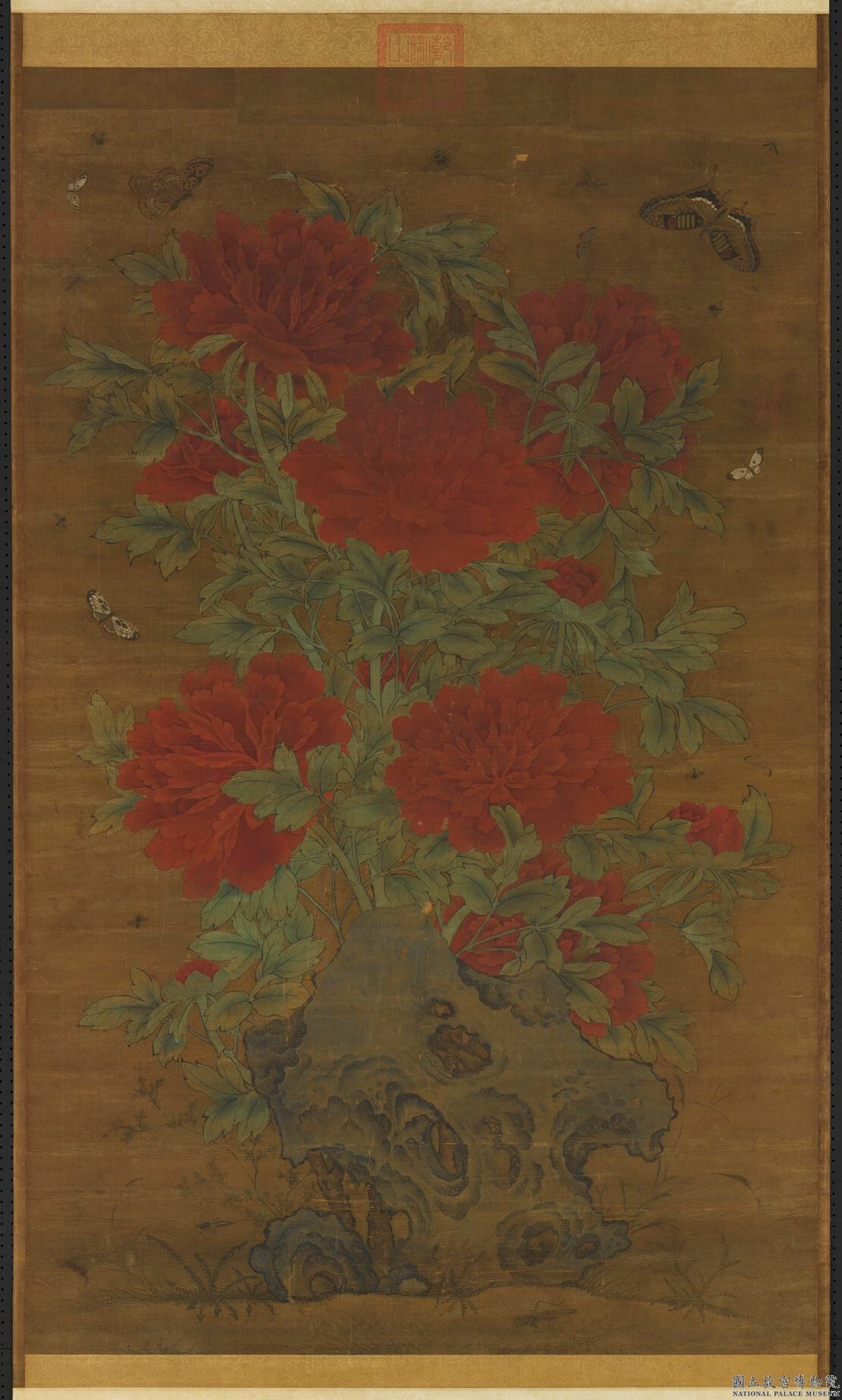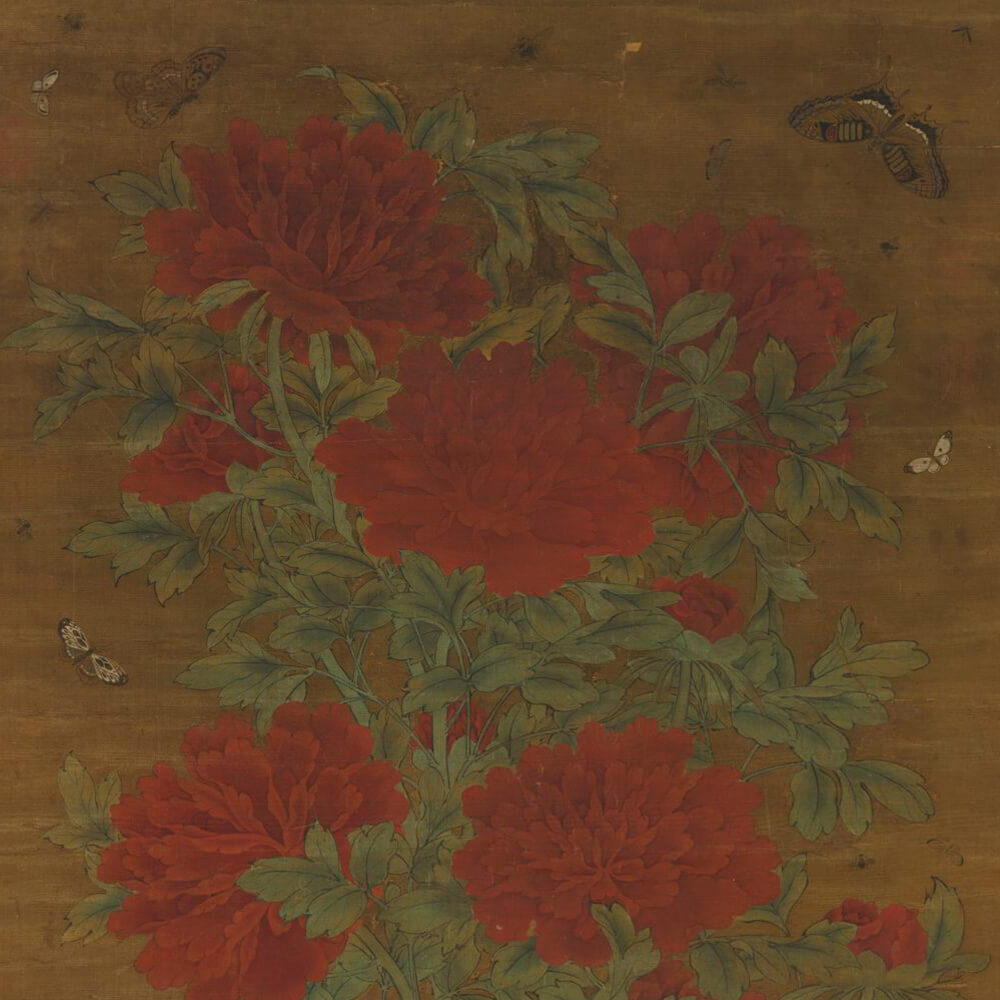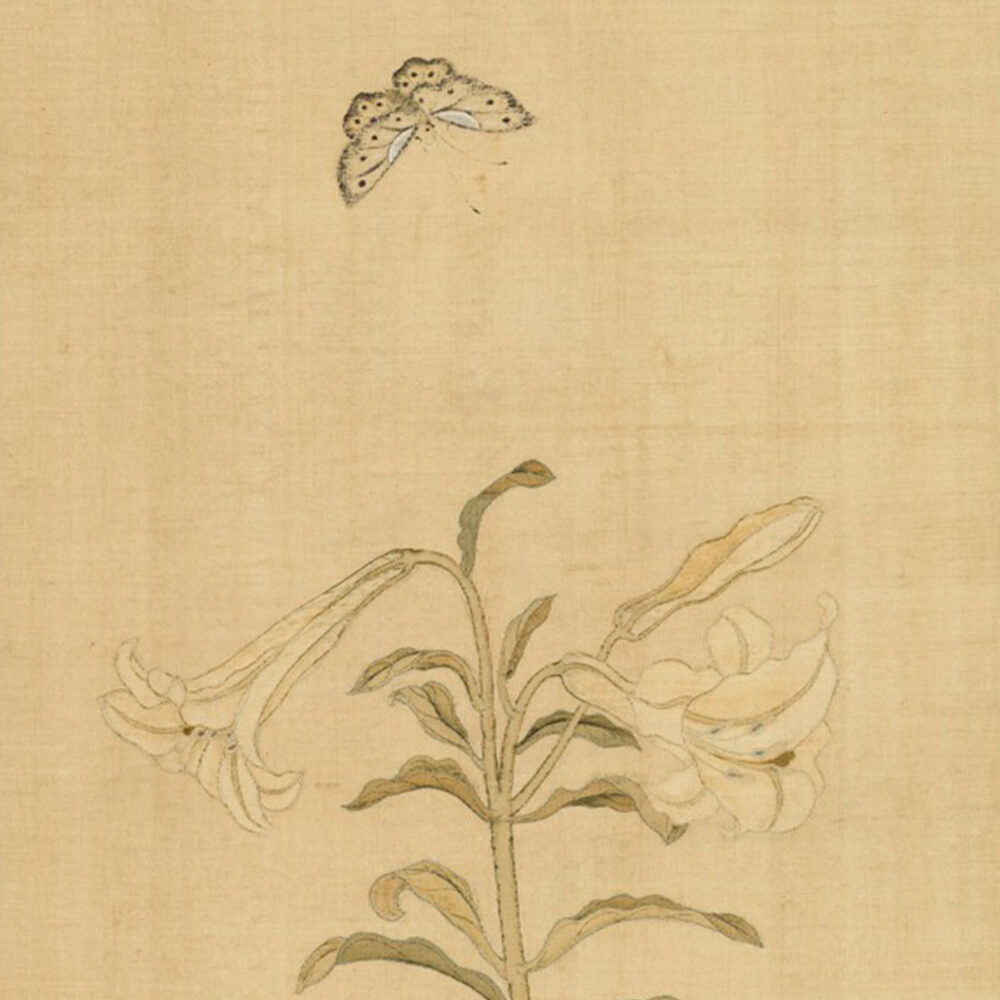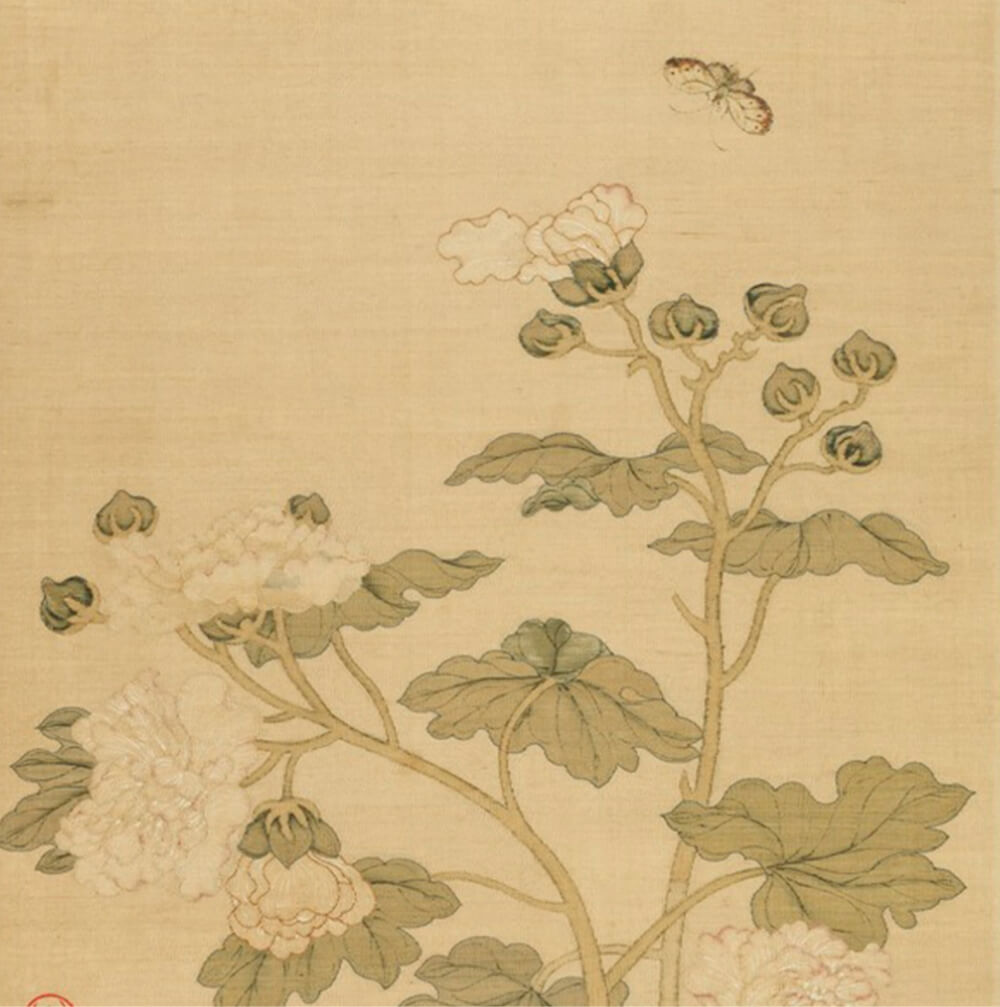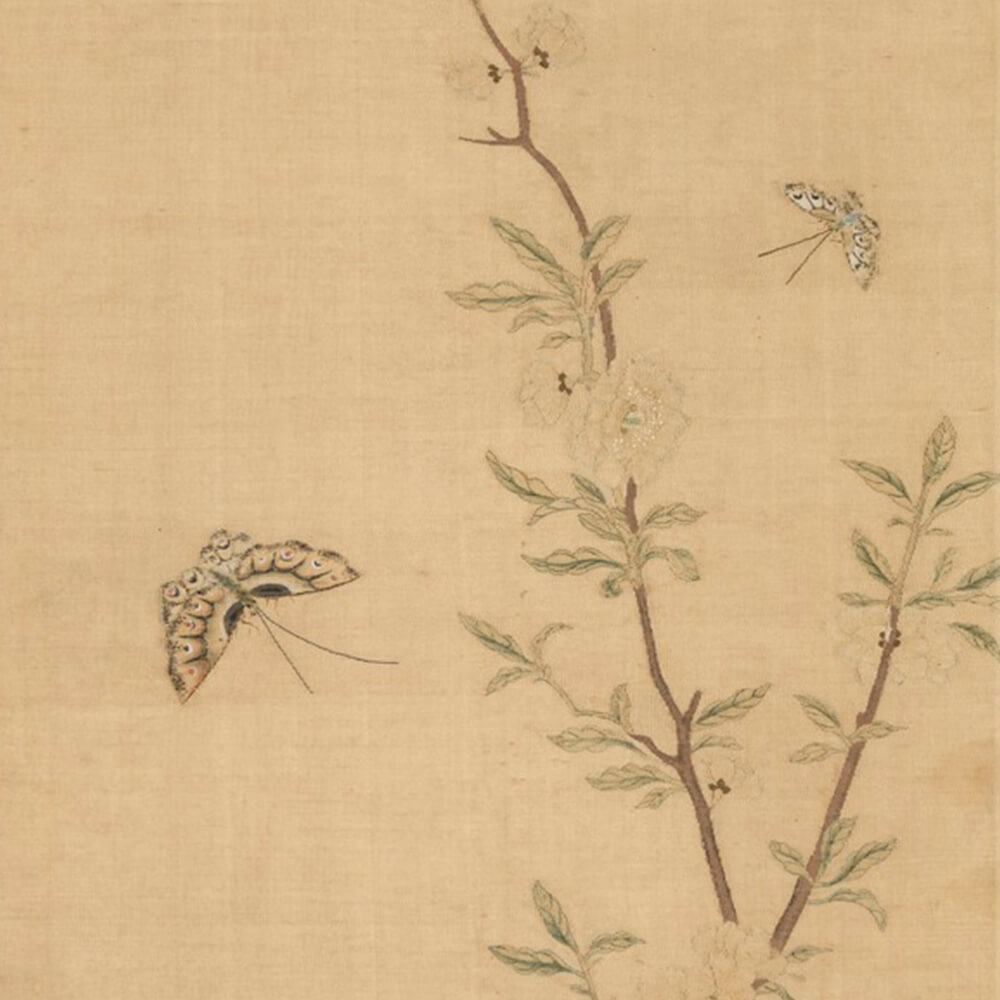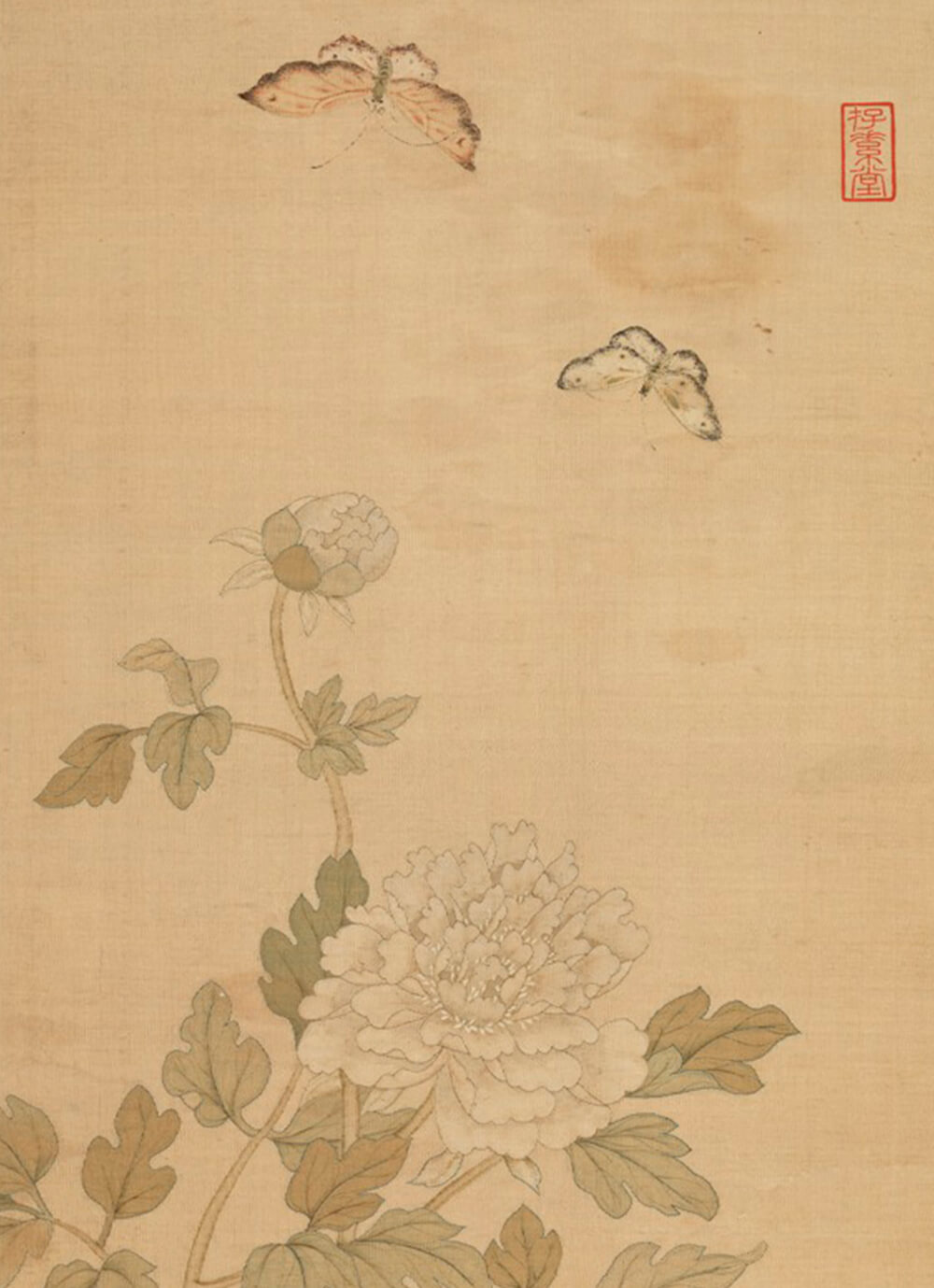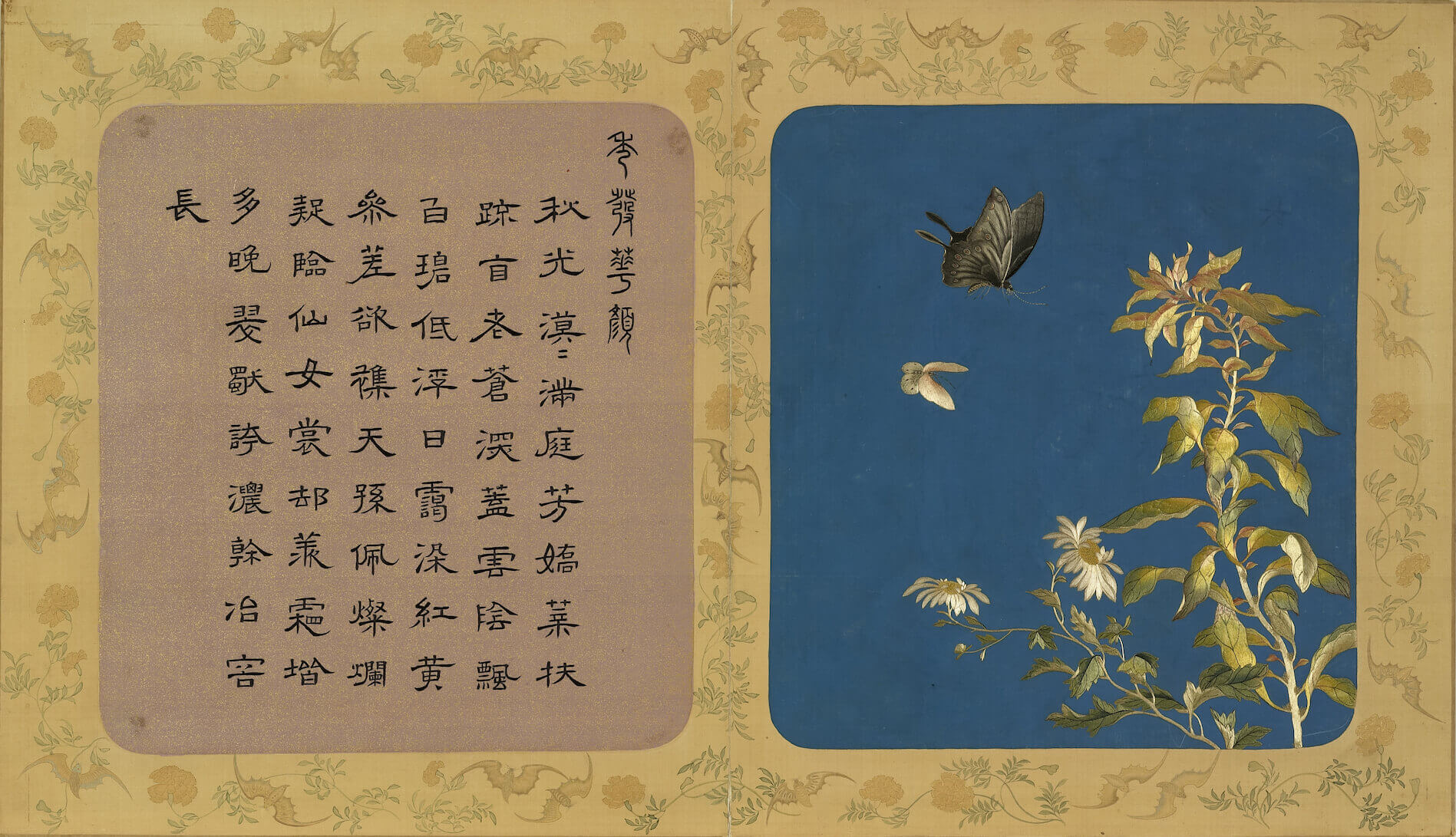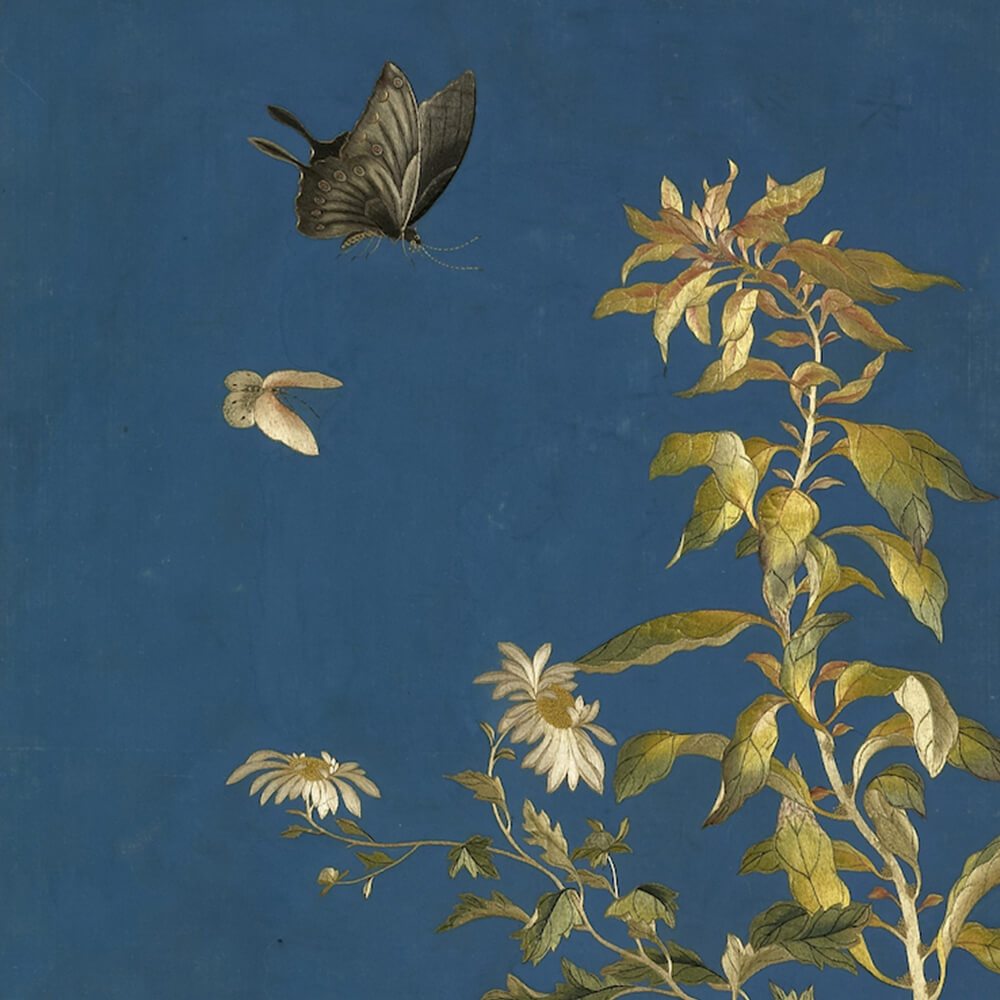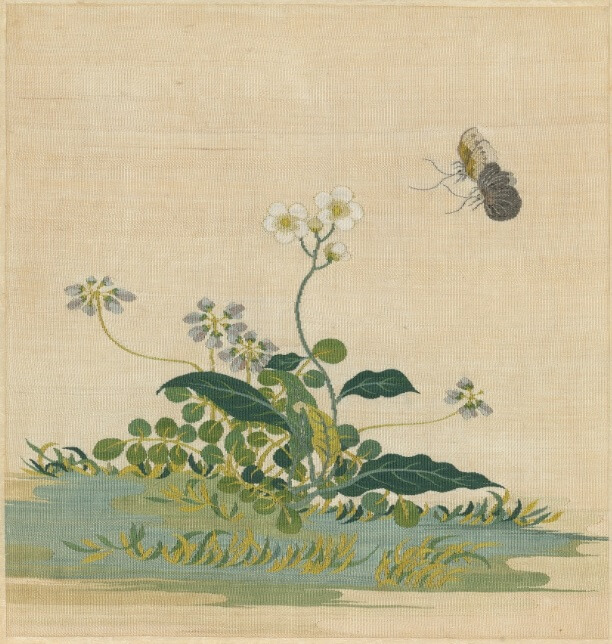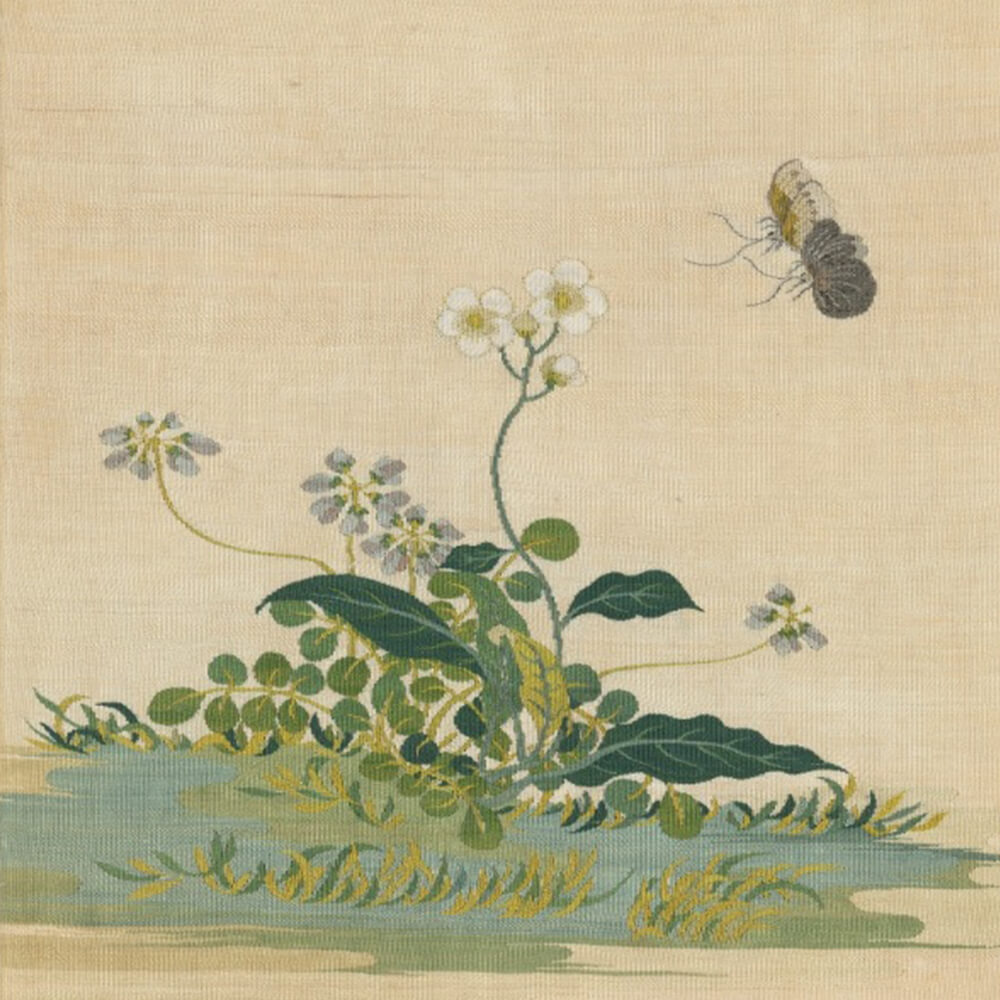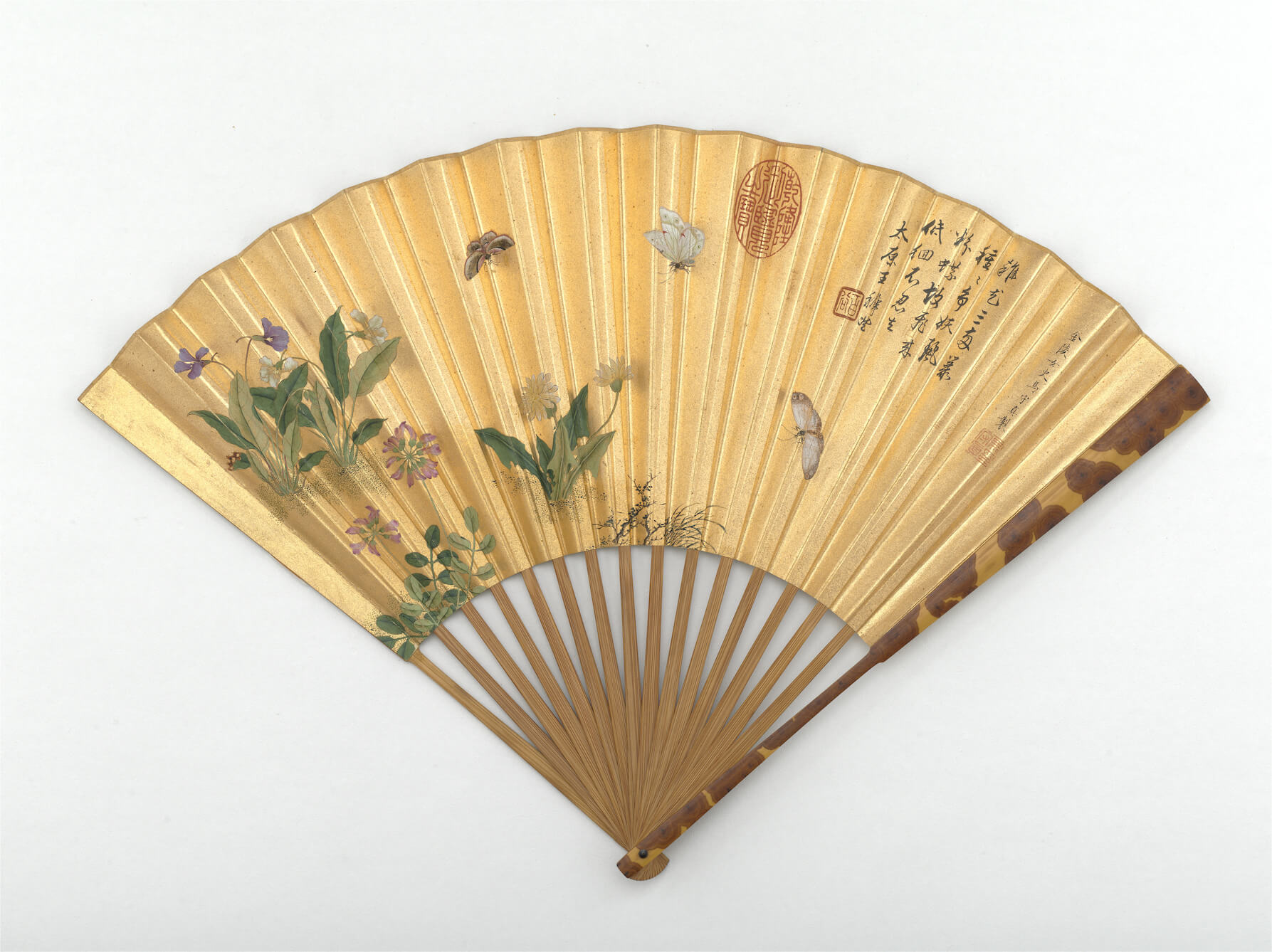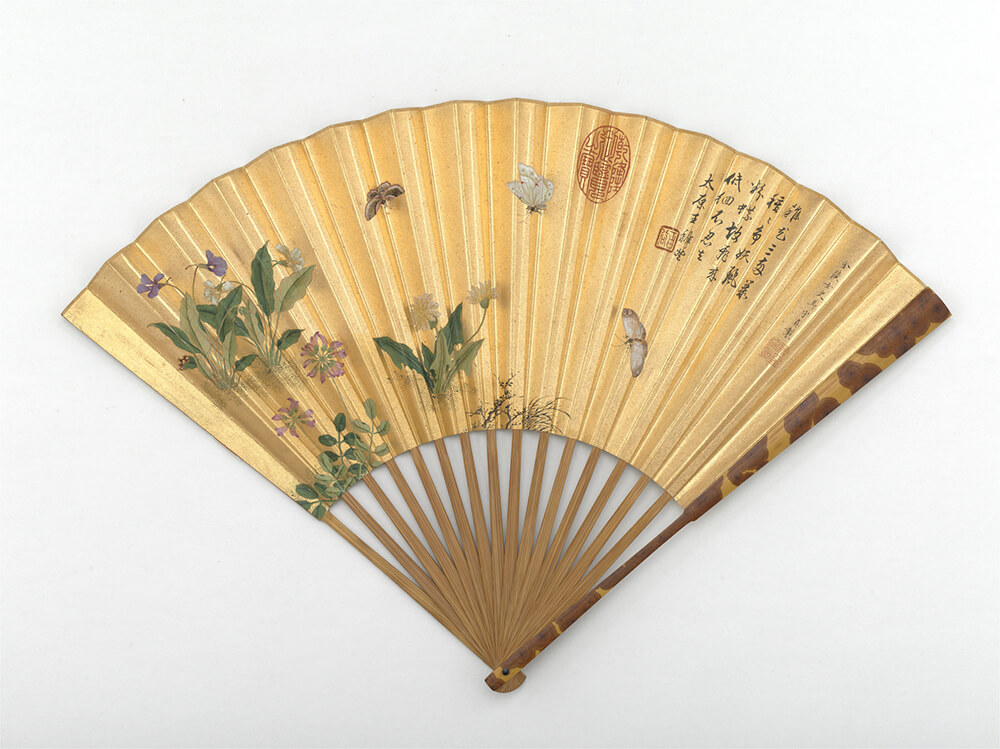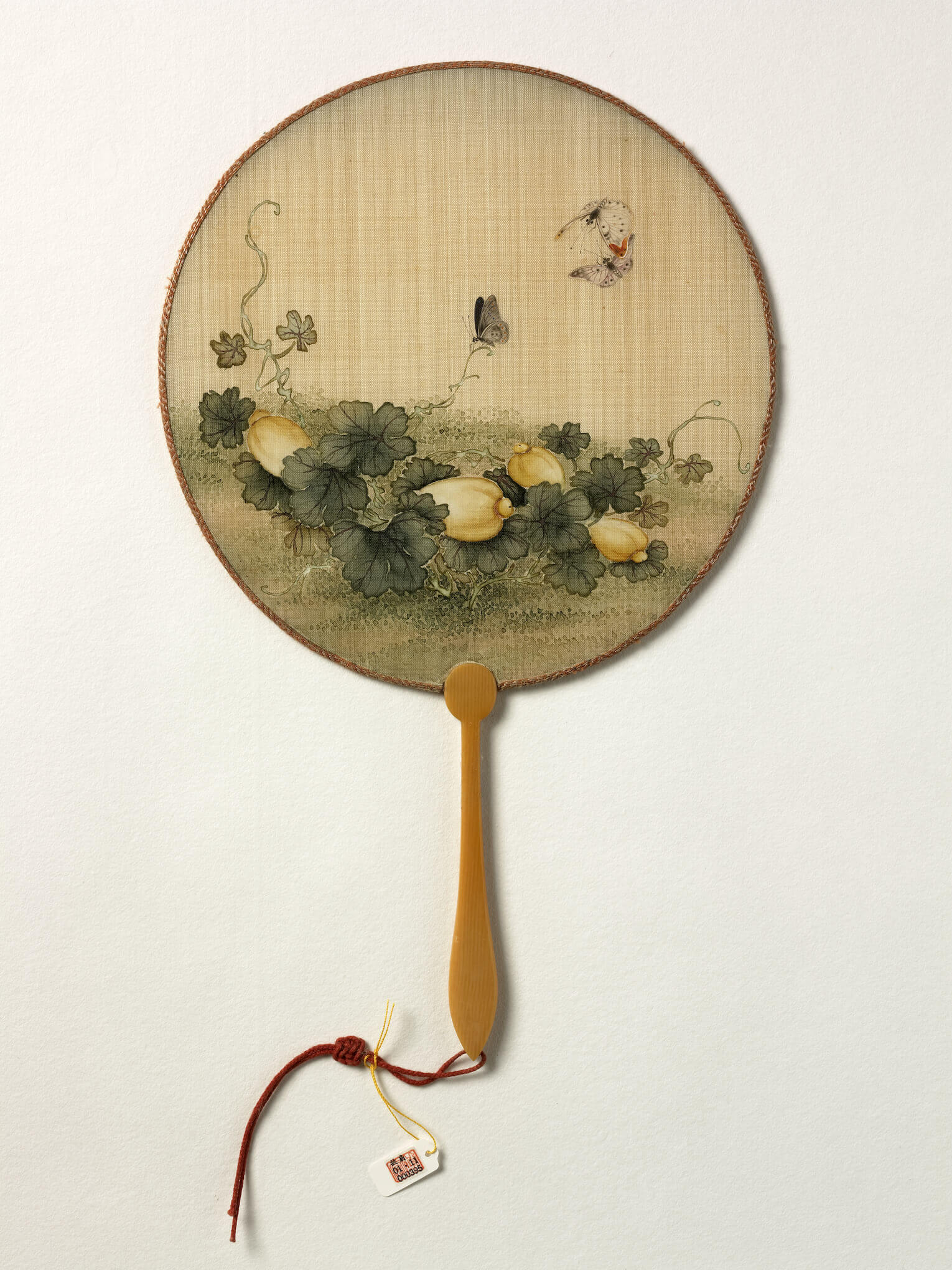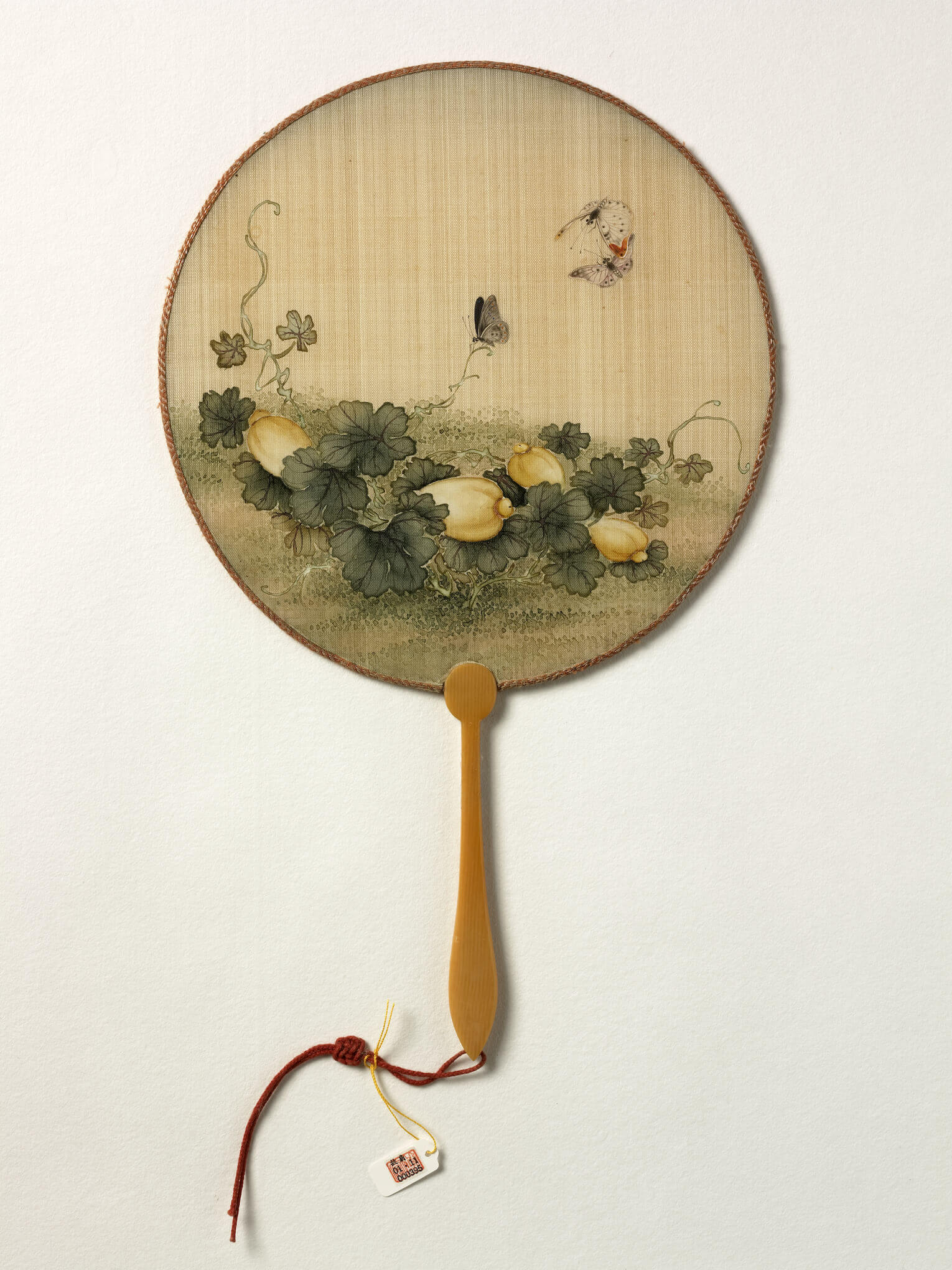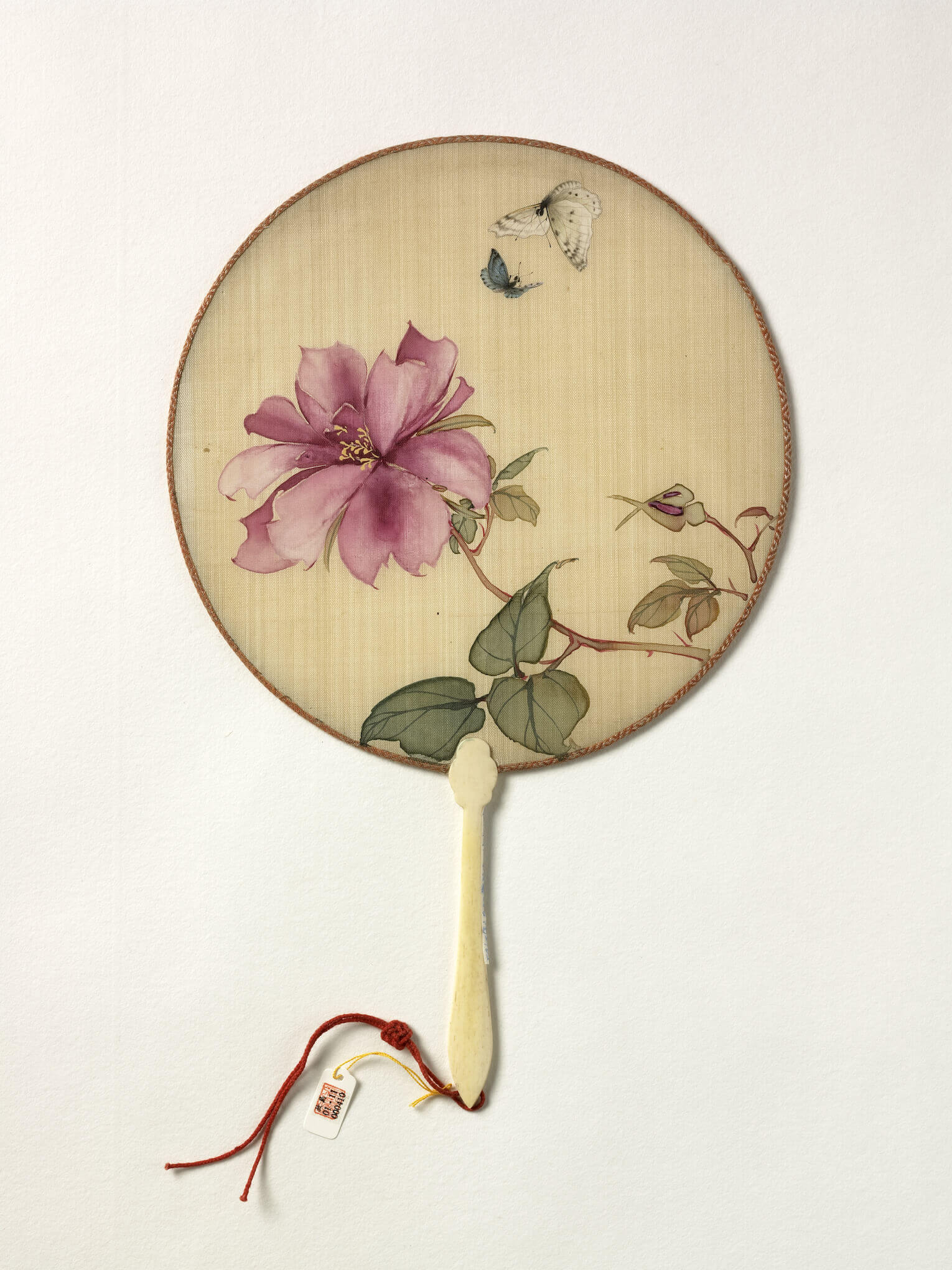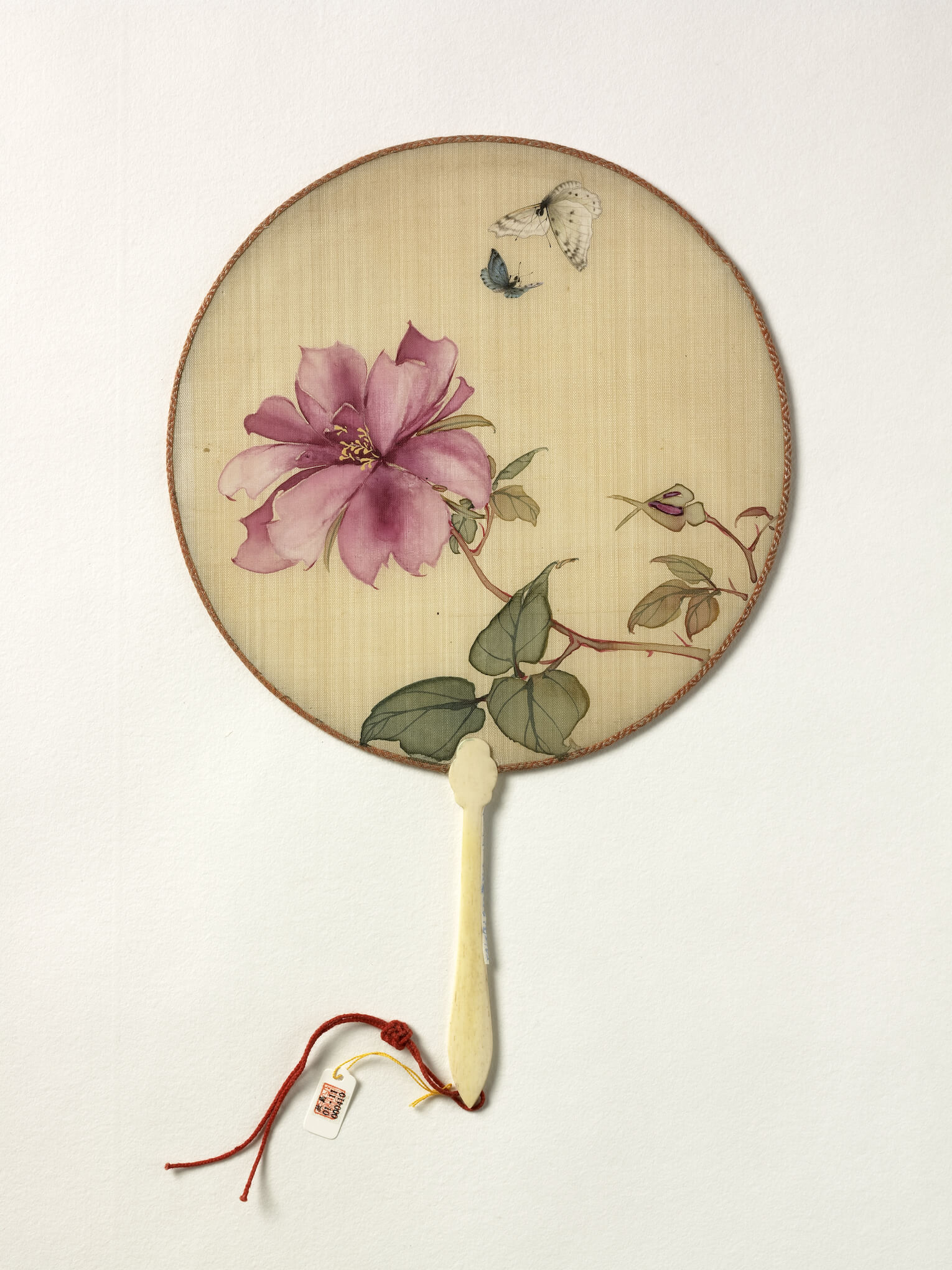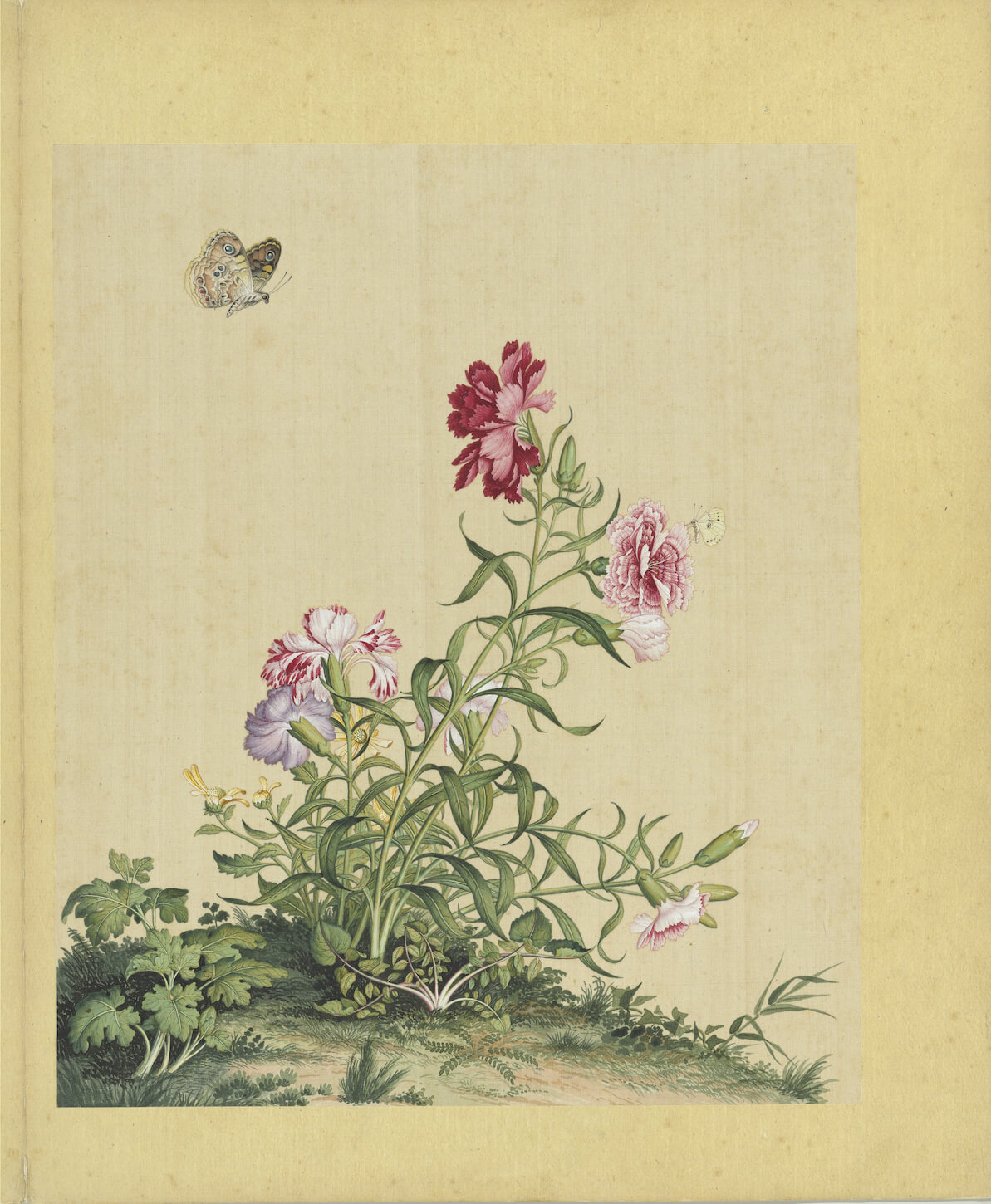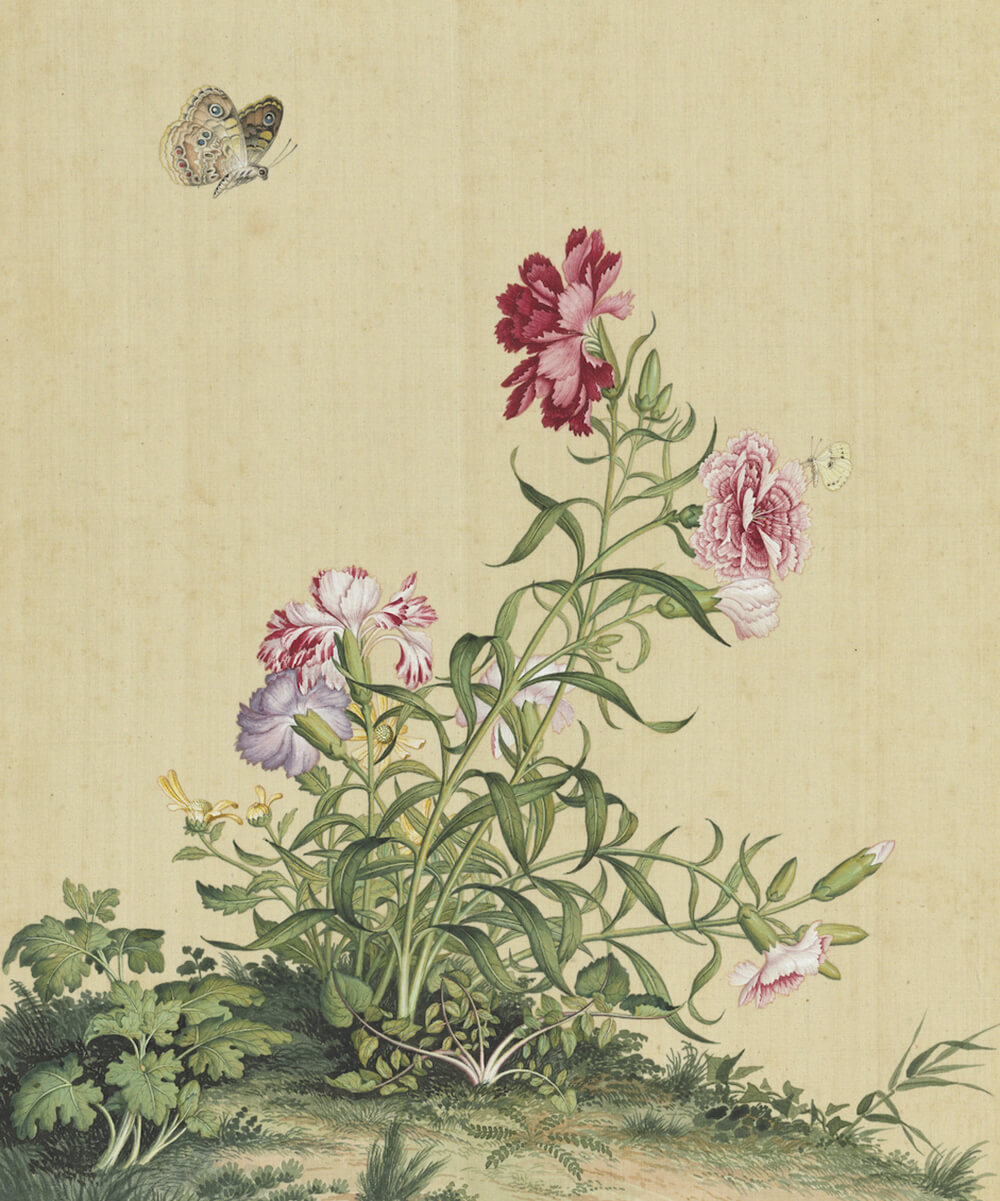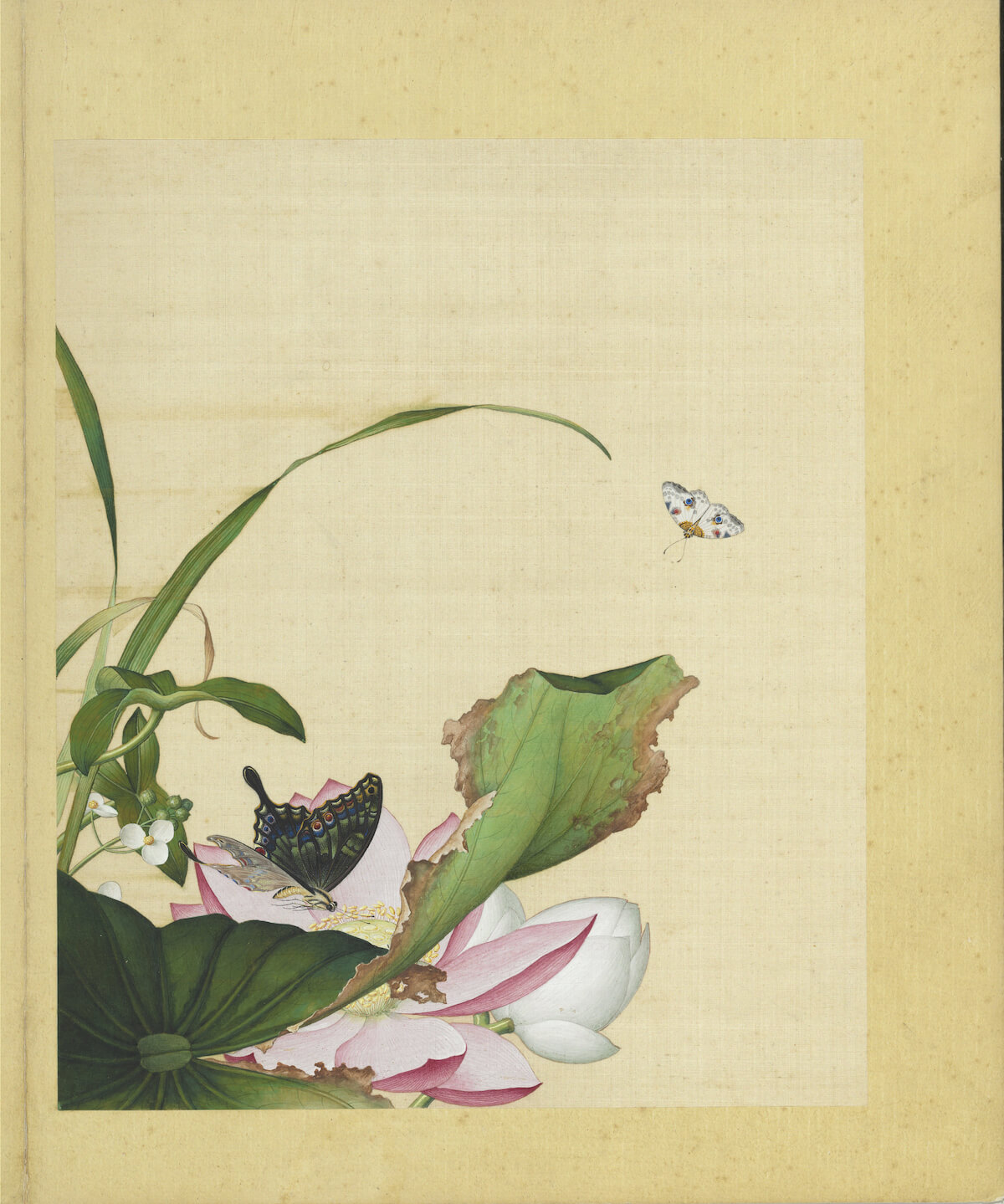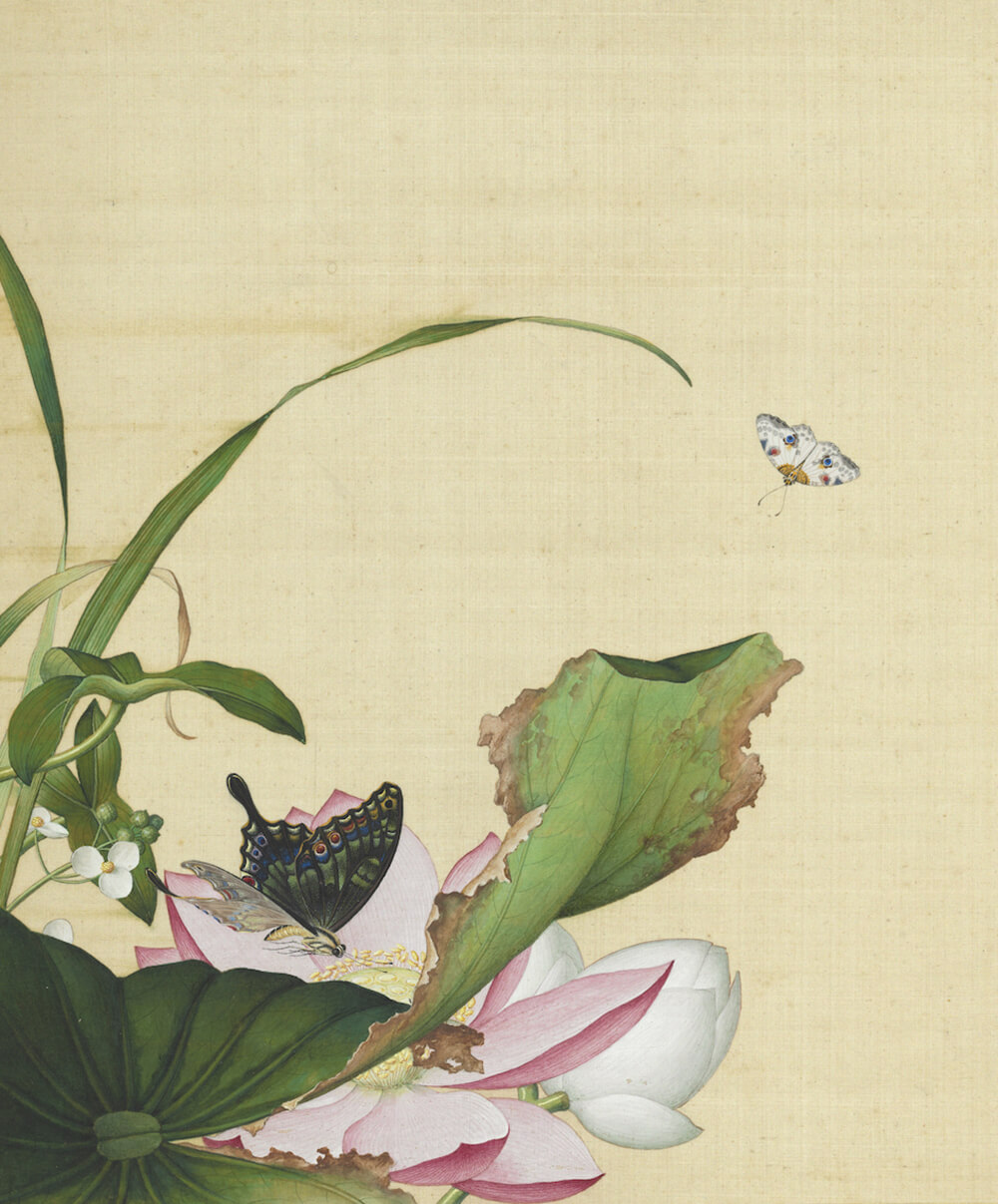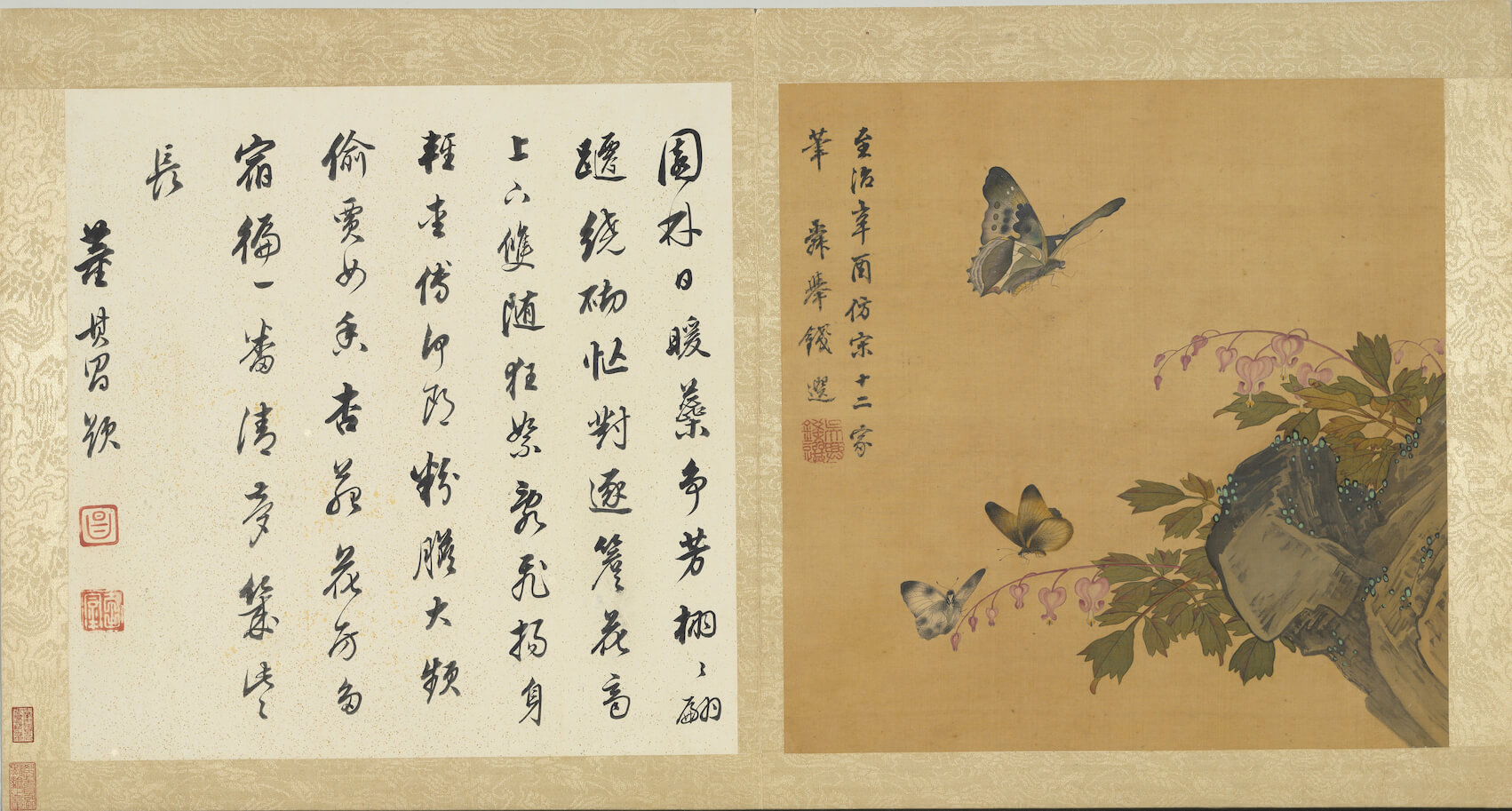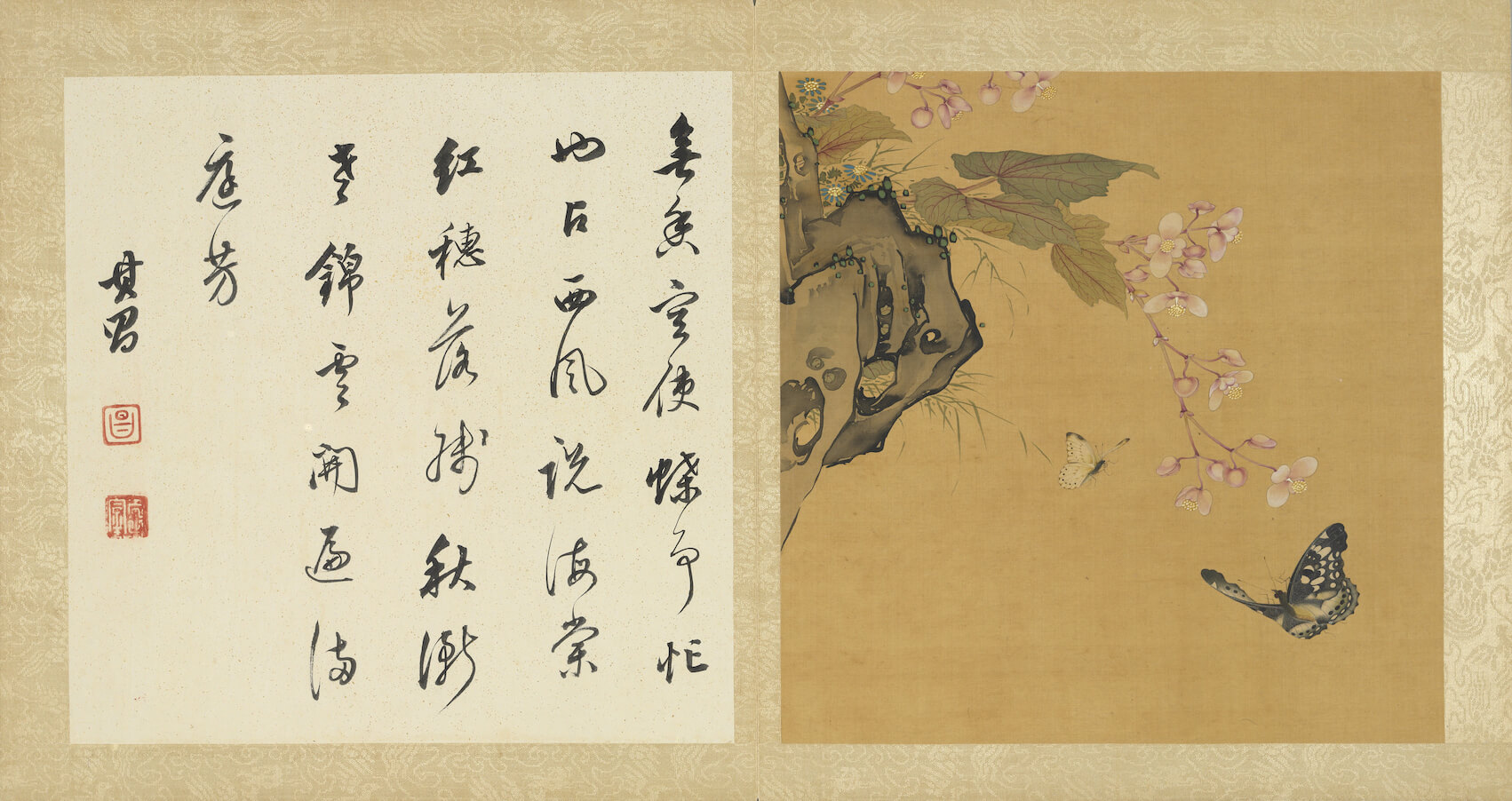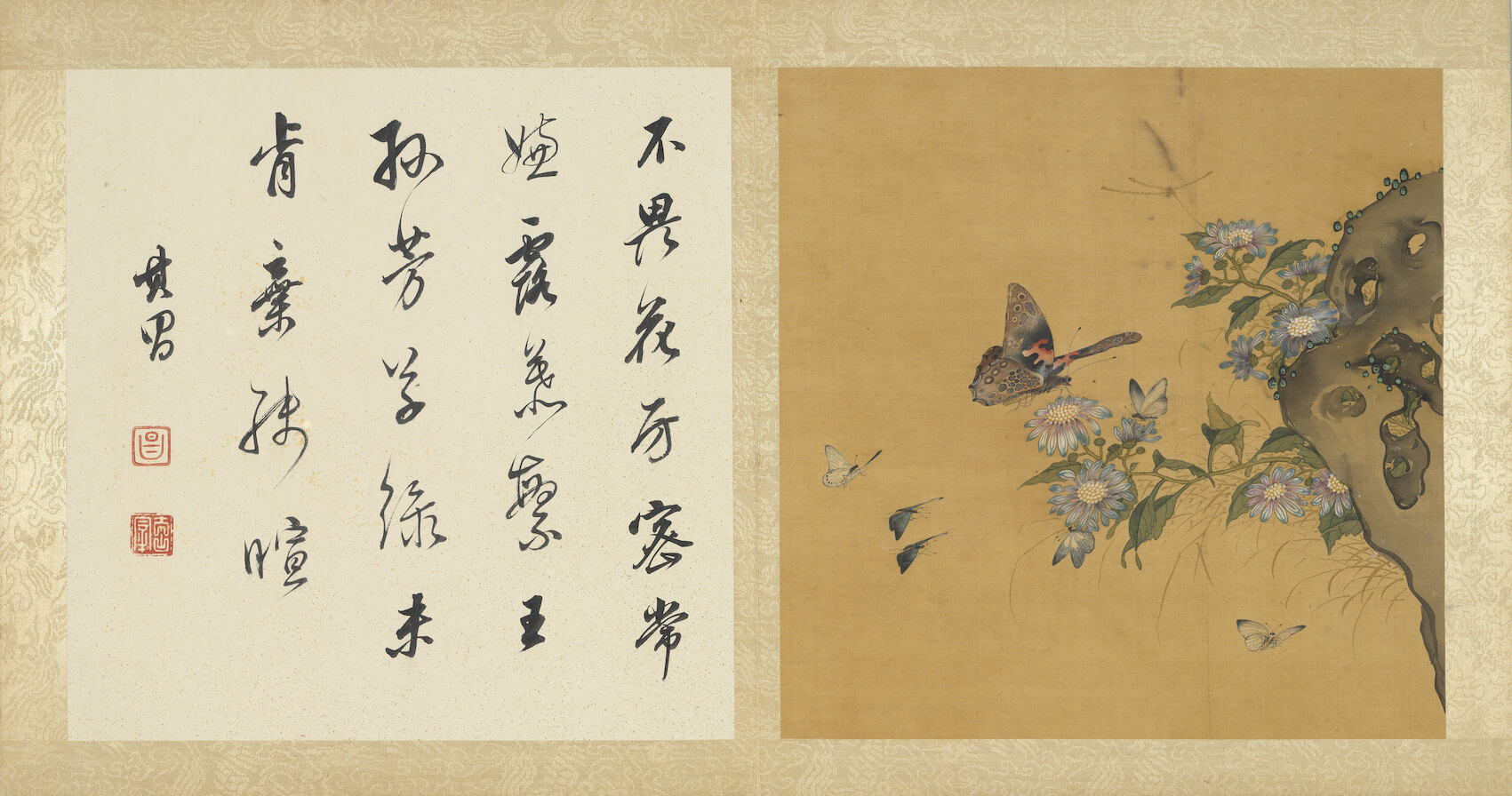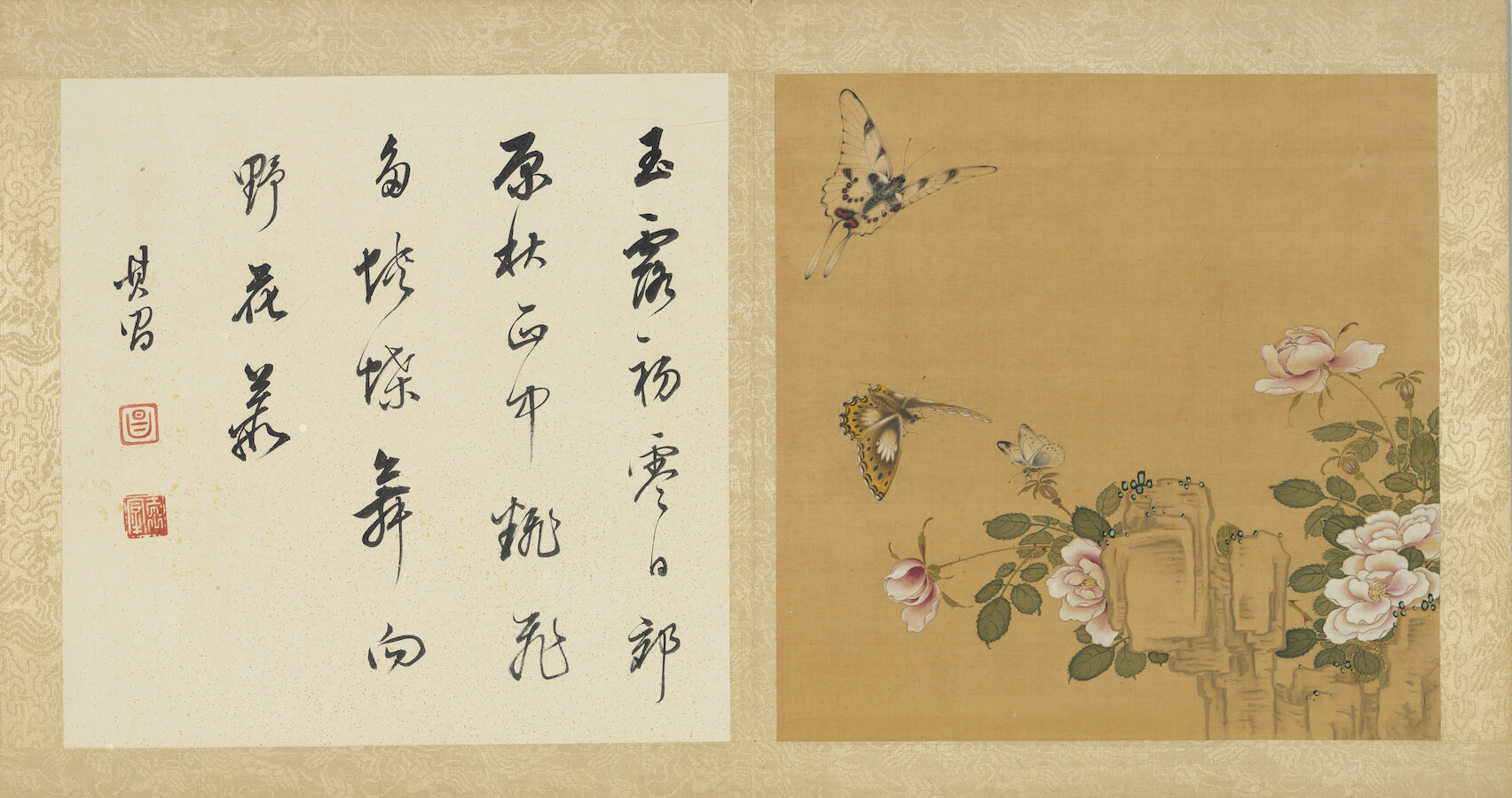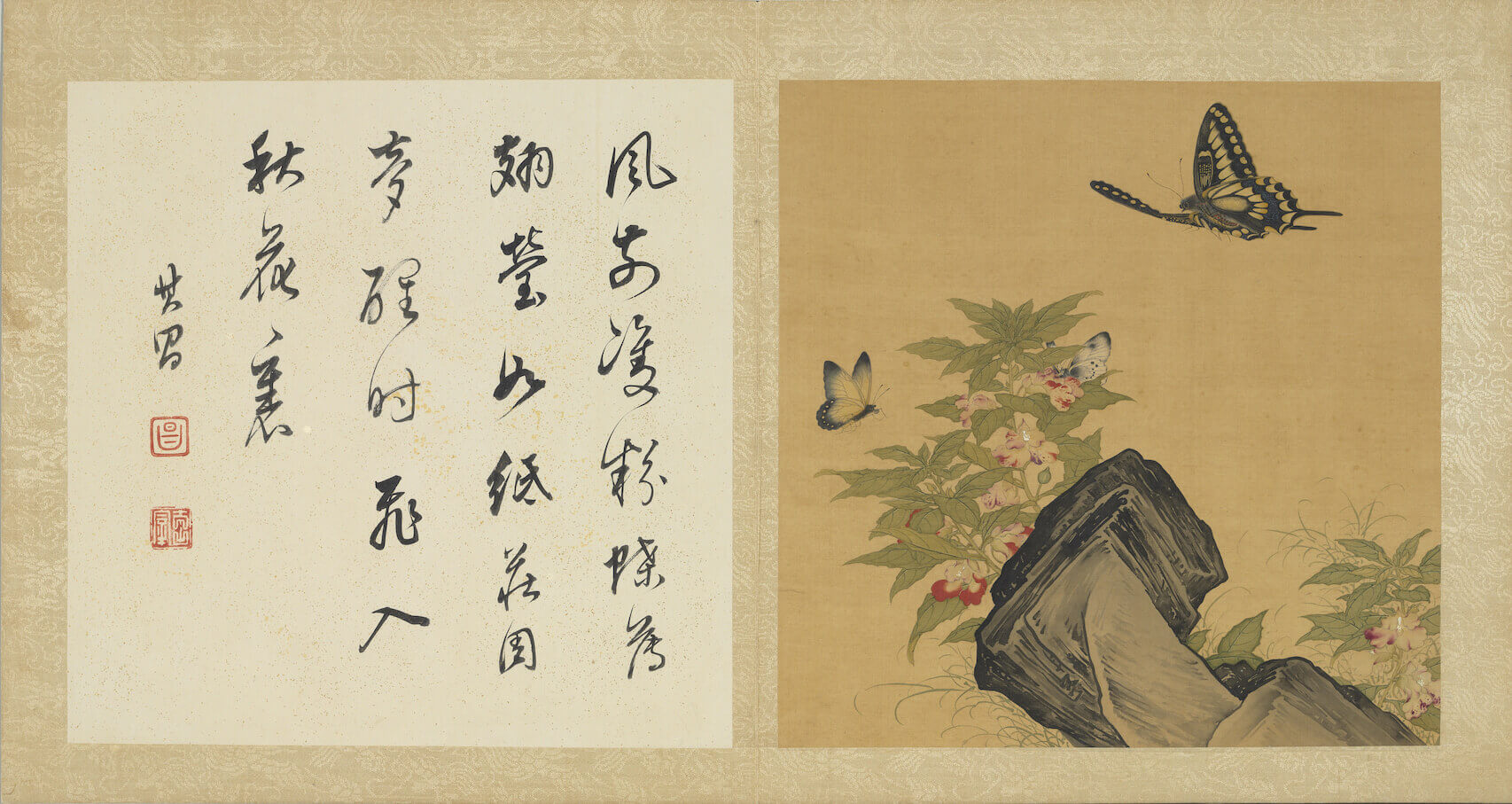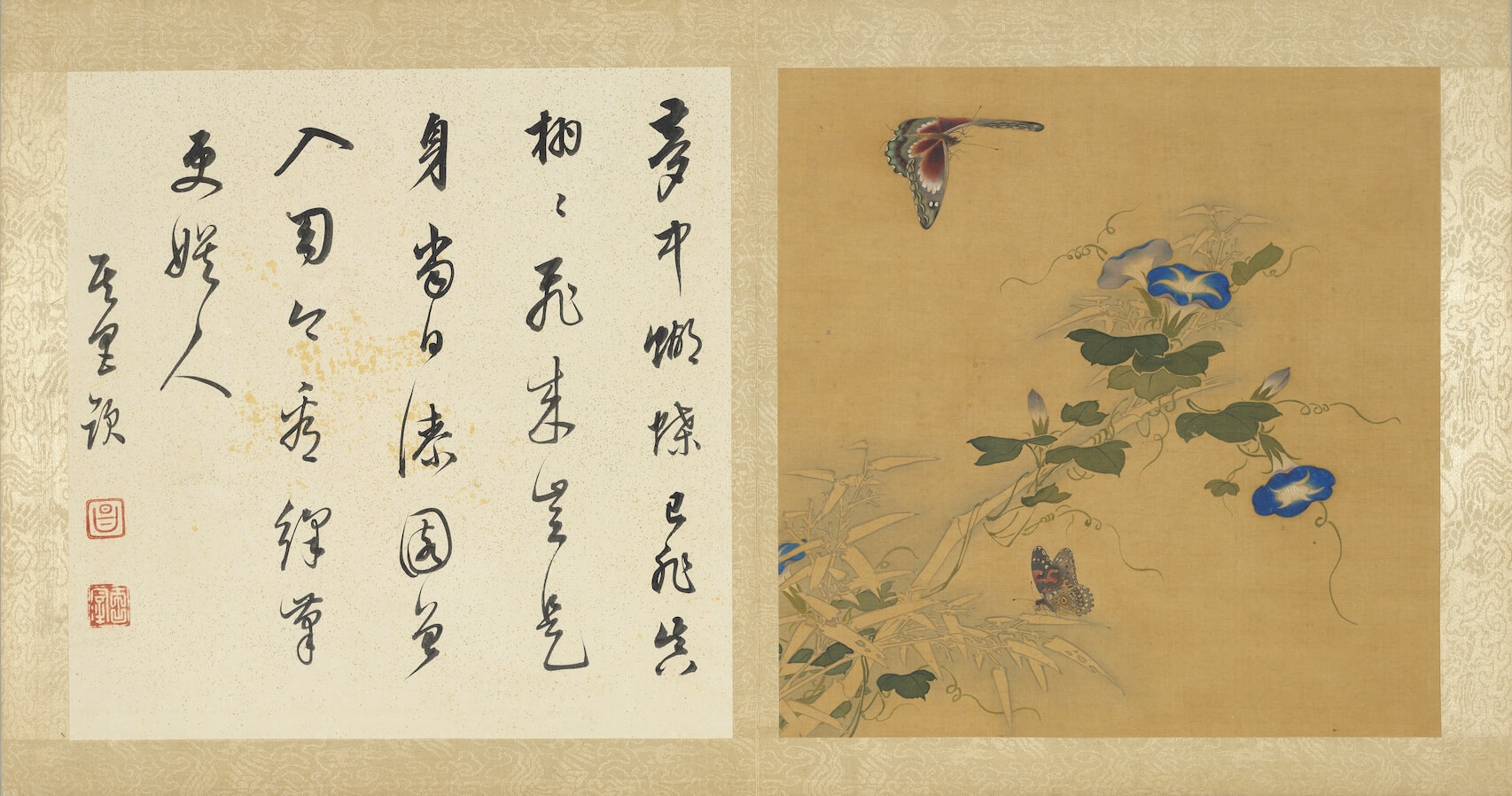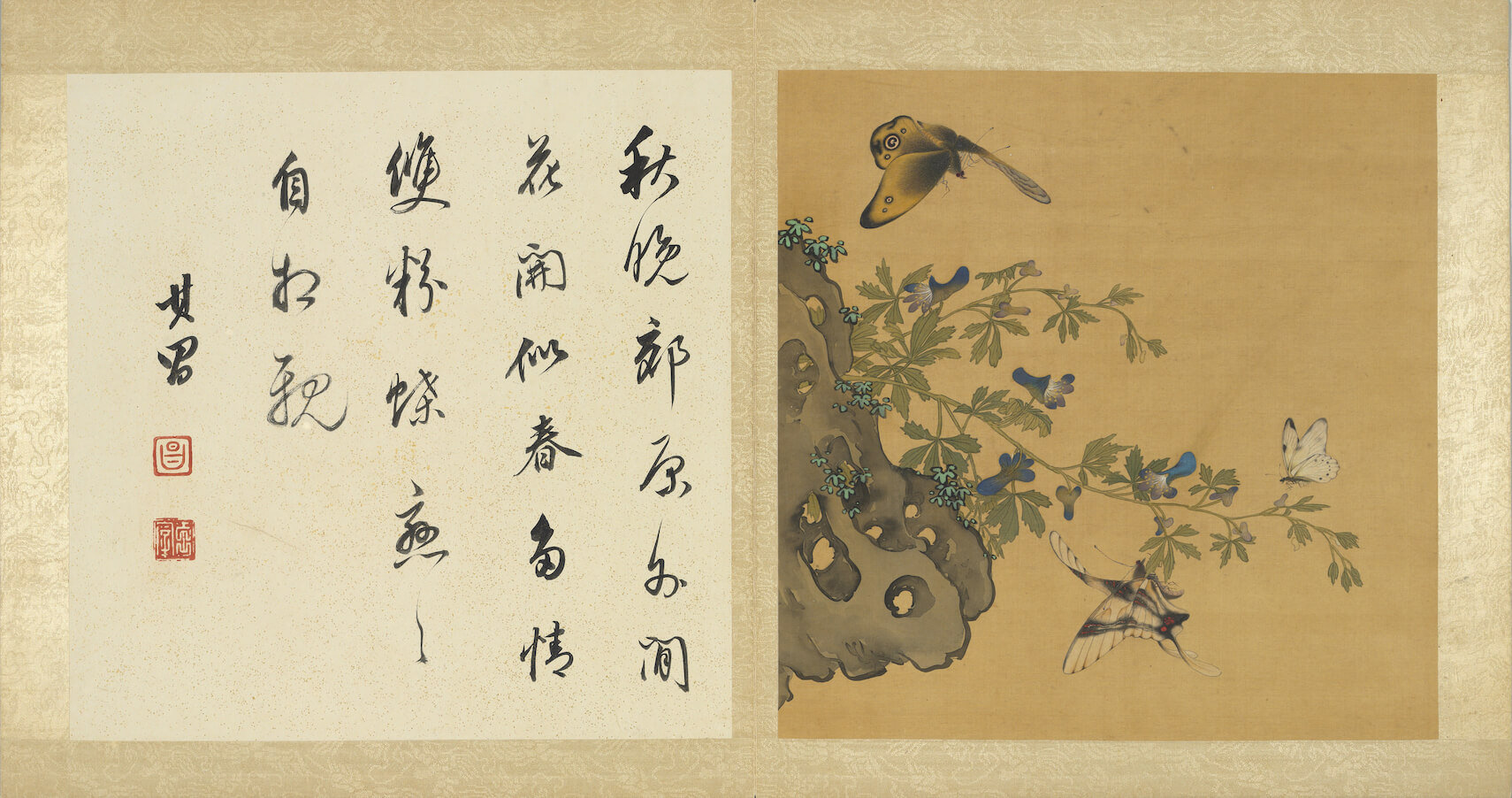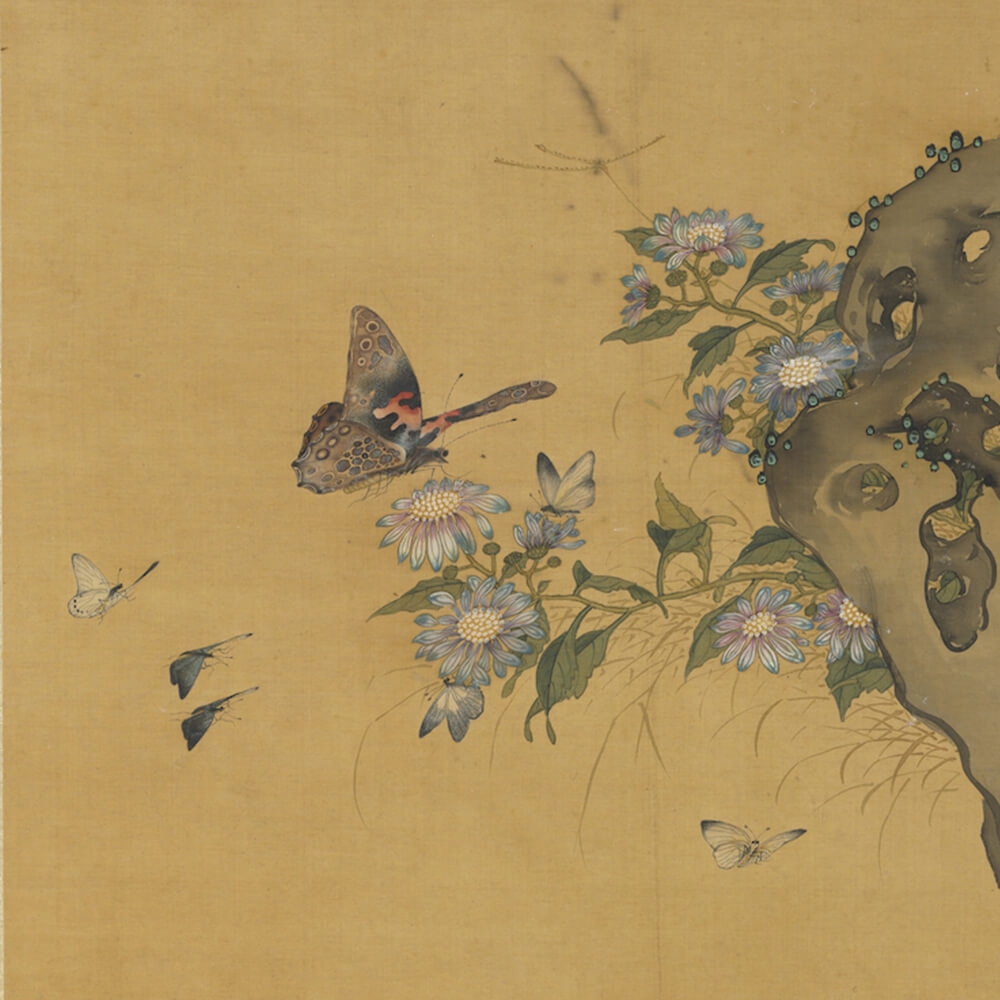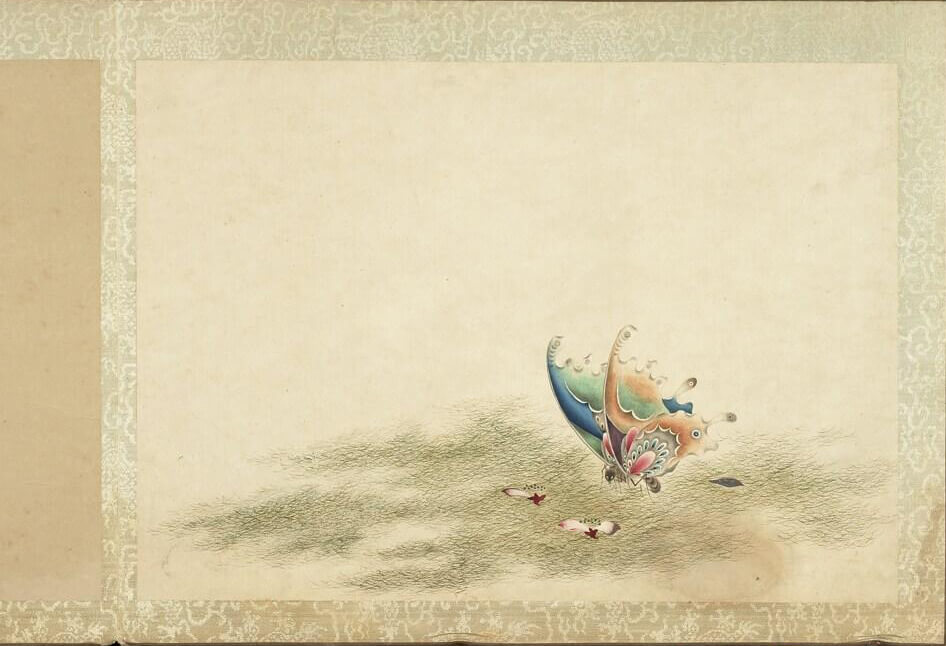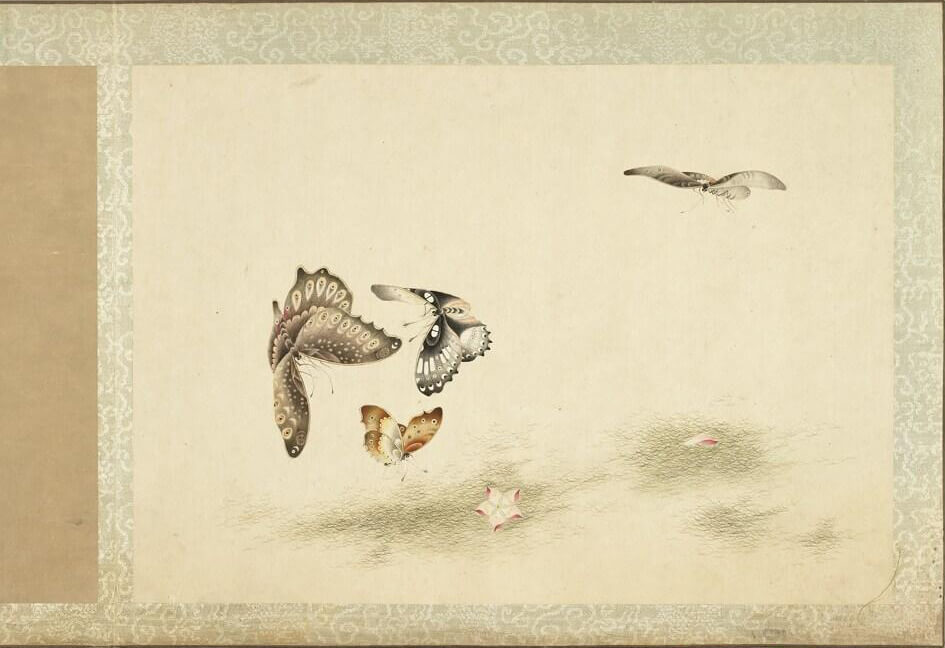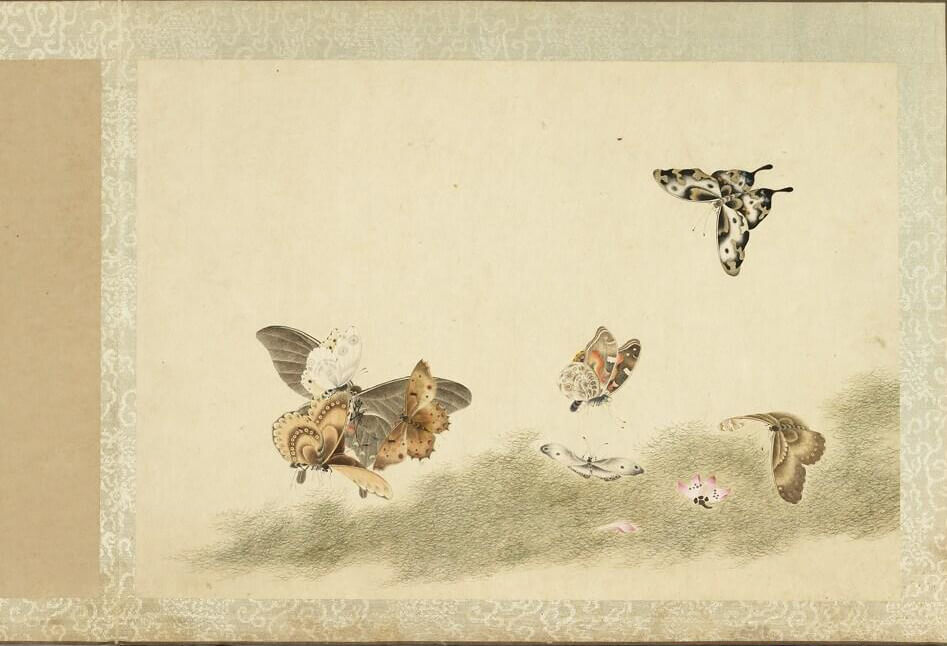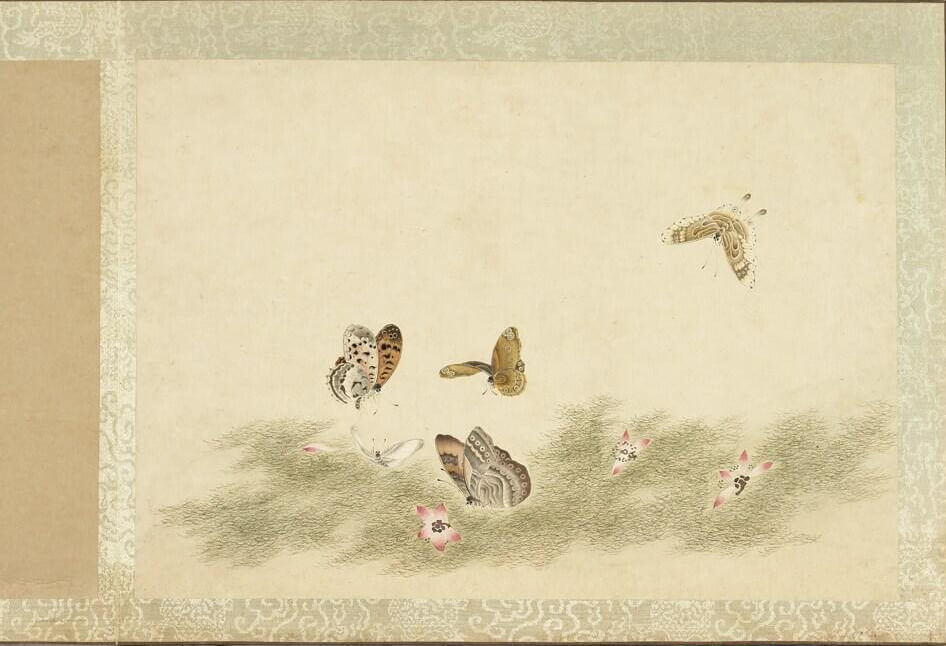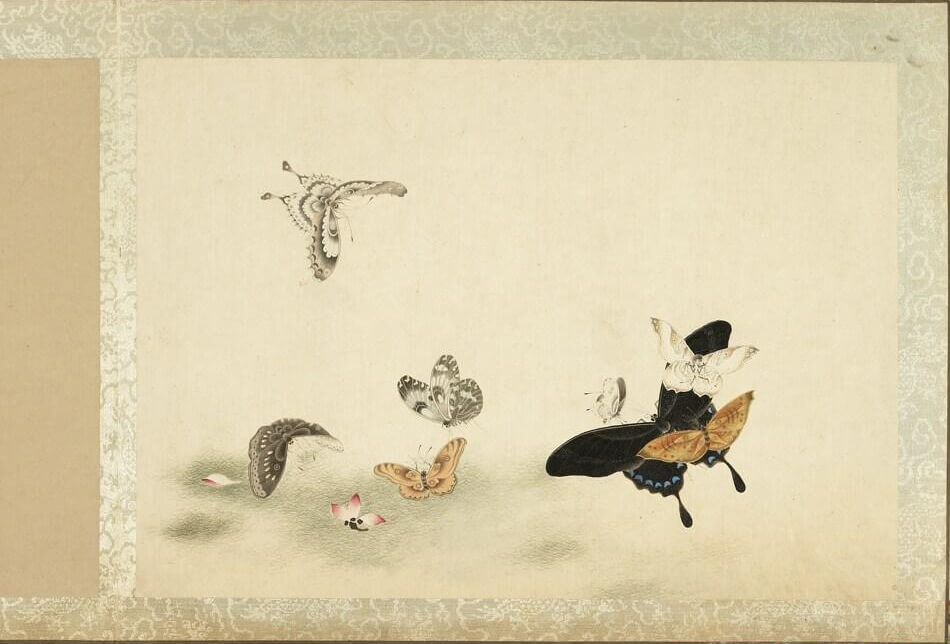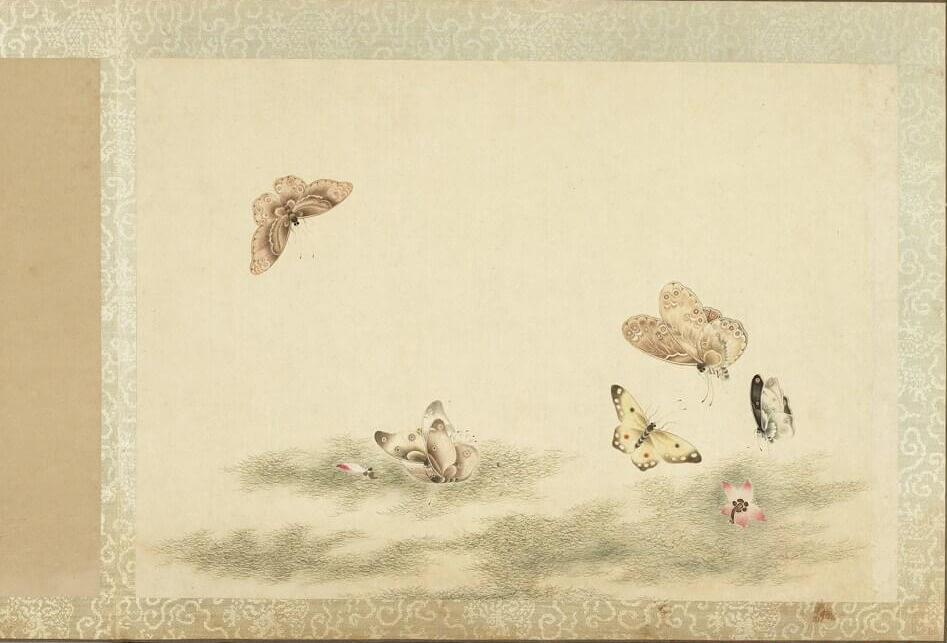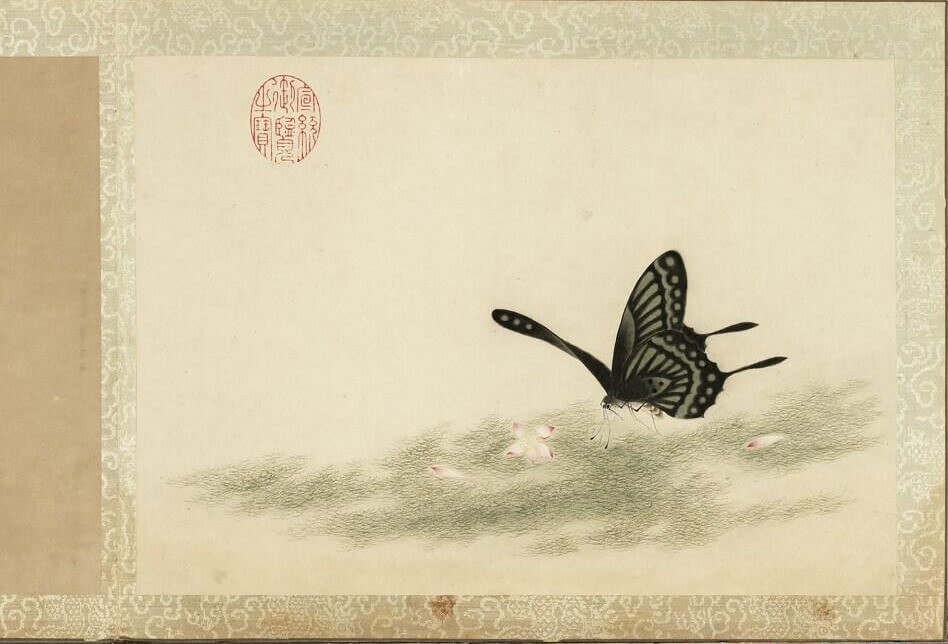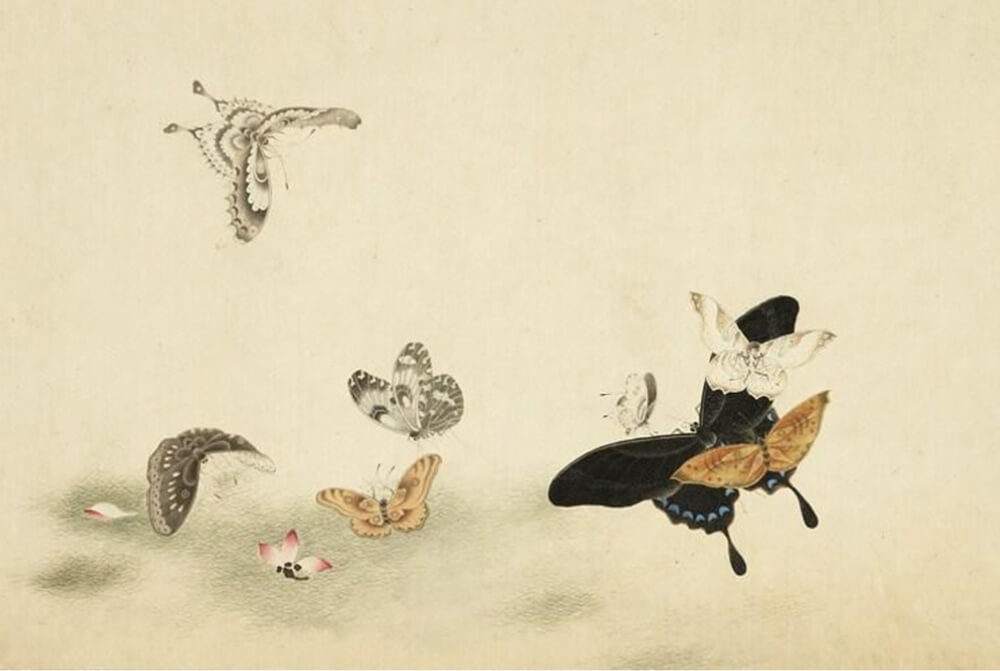The Star of Caochong - Butterflies
Butterflies have wings in distinct and delightful colours; the pronunciation of 'die (butterfly)' and the '耋' character that means elders over seventy or eighty years old are homonyms, and so it also represents the blessing of longevity. The attractive appearance and the favourable metaphor make the butterfly the most popular star of caochong paintings.
The entomologists attempted to identify all butterflies from these selected artworks; some are realistic and possible to know the species, while some are created from imagination. The speculation made on the imaginary butterflies is that they are the combination of different butterflies or partially joining with features of other species to form the non-existed beauty, hence demonstrating the painter's imaginative expression. Can you tell which butterflies truly exist?
- Flowers and Moth
- Zhao-Wen Chu (1595-1654), Ming dynasty
ZhaoWen Chu (1595-1634), with the style name Duanrong, originated from Changzhou in Jiangsu Province. Zhao was the great-grandchild of Wen Zhengming (1470-1559). She was a renowned female painter in the late Ming that excelled in flower, bird, and ;caochong ;paintings
This piece was done in 1630; her portrayal focused on peculiar stones, daylilies, and a flying luna moth. She placed a few daylilies and a viridescent luna moth flying above to present a sense of elegance and grace.
Open Data Download
- The King of Flowers
- Anonymous, Song dynasty (960-1279)
The painting depicts a peony in full bloom thriving from behind a peculiar-shaped Taihu stone. The Taihu stone and peony are both situated in the centre of the image; this composition of placing objects in the middle dates back to the Tang dynasty. Many wall paintings in the tombs after the Tang dynasty shared a similar structure when painting screens of flowers and birds. These highly decorative artworks often have the plants surrounded by insects and butterflies; this is possibly the earliest origin of caochong painting on the hanging scrolls.
Open Data Download
- Embroidered Panel of Flowers (I)
- Qianlong reign (1736-1795), Qing dynasty
The four panels of hanging scrolls illustrate blossoms, butterflies and lake stones in brilliant and skilful embroidery. The lake stones are tinted in blue and green, and the flowers and leaves use hook strokes to paint the outline, while the green, blue and ink colours portray the shapes of the leaves; the method demonstrates the shades of branches and leaves that caused by the angle of lights. The colouration is exquisite; the coordination of embroidery and painting presents the signature of embroidery from the latter Qianlong (1711-1799) period.
- Embroidered Panel of Flowers (II)
- Qianlong reign (1736-1795), Qing dynasty
The four panels of hanging scrolls illustrate blossoms, butterflies and lake stones in brilliant and skilful embroidery. The lake stones are tinted in blue and green, and the flowers and leaves use hook strokes to paint the outline, while the green, blue and ink colours portray the shapes of the leaves; the method demonstrates the shades of branches and leaves that caused by the angle of lights. The colouration is exquisite; the coordination of embroidery and painting presents the signature of embroidery from the latter Qianlong (1711-1799) period.
Open Data Download
- Embroidered Panel of Flowers (III)
- Qianlong reign (1736-1795), Qing dynasty
The four panels of hanging scrolls illustrate blossoms, butterflies and lake stones in brilliant and skilful embroidery. The lake stones are tinted in blue and green, and the flowers and leaves use hook strokes to paint the outline, while the green, blue and ink colours portray the shapes of the leaves; the method demonstrates the shades of branches and leaves that caused by the angle of lights. The colouration is exquisite; the coordination of embroidery and painting presents the signature of embroidery from the latter Qianlong (1711-1799) period.
Open Data Download
- Embroidered Panel of Flowers (IV)
- Qianlong reign (1736-1795), Qing dynasty
The four panels of hanging scrolls illustrate blossoms, butterflies and lake stones in brilliant and skilful embroidery. The lake stones are tinted in blue and green, and the flowers and leaves use hook strokes to paint the outline, while the green, blue and ink colours portray the shapes of the leaves; the method demonstrates the shades of branches and leaves that caused by the angle of lights. The colouration is exquisite; the coordination of embroidery and painting presents the signature of embroidery from the latter Qianlong (1711-1799) period.
- Luxuriant Beauty
- Anonymous, Qing dynasty (1644-1911)
- From the album "Embroidery of Everlasting Verdure of Elysian Parks"
This image illustrates a common subject of paired butterflies flying among the plants. What makes this piece extraordinary is that the picture is not 'painted' with a brush, but a work of embroidery done with stitches of threads. This album is possibly the most precious collection of the NPM that elaborates the vibrance of embroidery artwork
The craftsman carefully arranged the length and direction of these fine threads to achieve evenness. Under the lights, the brilliant shimmer of the vibrant colours also brings glamour to the butterflies and blossoms to a higher level.
- Pair of Butterflies and Pea Blossoms
- Anonymous textile, Ming dynasty (1368-1644)
- From the album "Birds and Flowers Sketched from Life"
This embroidery has coloured pea blossoms and paired butterflies on white ground. The vibrant colouration collaborates with the consistent weaves to deliver a vivid portrayal. The piece uses twisting silk as the material to create an even surface. This embroidery is preserved in excellent condition.
- Flowers and Butterflies
- Ma Shouzhen (1548-1604), Ming dynasty
Ma Shouzhen (minor style names Xuan'er, Xuanxuanzi; style name Yuejiao; sobriquet Xianglan) was a courtesan of Jinling (modern Nanjing) and one of the Eight Beauties of Qinhuai. She was quite famous for her poetry and painting, both at home and abroad; it is said that an envoy from Siam was dispatched to buy her painting for a hefty price, showing how valued her art was. The painting here depicts a serene courtyard scene with butterflies and a moth flitting among dandelions, purple clover, and violets, the coloring refined and elegantly beautiful for an atmosphere of purity and peace. In the upper right is a five-character truncated verse by Wang Zhideng (1535-1612), a leading scholar at the time, that reads, "A few clumps of wild blossoms, the various kinds compete in beauty. Butterflies have therefore come, flitting about not wanting to leave." After Ma Shouzhen passed away, Wang wrote her biography and also twelve truncated verses lamenting her death.
Open Data Download
- Flowers
- Anonymous, Qing dynasty (1644-1911)
The fan painted for the empress illustrated butterflies of 'longevity' flying above melon and fruit that symbolized 'everlasting generations', possibly done by the Qing court painter in the late 19th to early 20th century.
The painter captured the brightness with light colouration in layers, and this technique could be influenced by Western painting that focused on light and shades. This fan stands as an inherited taste in the palace.
- Flowers
- Anonymous, Qing dynasty (1644-1911)
This fan was also a piece of the court painters in the late Qing. The head part of butterflies follows the traditional painting method; The colours of the petals demonstrate dramatic changes in shades that present a sensational visual. Nonetheless, each tint diffusing only within the outline holds the restrained elegance.
- Carnations
- Lang Shining (Giuseppe Castiglione, 1688-1766), Qing dynasty
These two album leaves came from the collection "Immortal Blossoms in an Everlasting Spring" by Italian missionary and painter, Lang Shining (1688-1766). The 7th leaf of 'Carnations' is adorned with a beautiful butterfly with wings in the colours of ruby and sapphire in the upper left corner. The attentive observations revealed that on the wings near the body and the eyes, a significant amount of white sprinkles added by Lang generate the effect of light reflections, which is unlike the traditional depictions.
- Lotuses, Arrowhead, and Butterflies
- Lang Shining (Giuseppe Castiglione, 1688-1766), Qing dynasty
The most intriguing detail of this 'Lotuses, Arrowhead, and Butterflies' is on the upper right of the image; an insect supposed to be a moth, instead misplaced with antennas of a butterfly. The realistic expression of the Western missionary and painter, Lang Shining had given the impression that his paintings only meticulously reflected the truth. This falsely painted moth enlightens us that painting skill is like magic, leading people to believe in nonexistent objects.
- Copy of Ancient Flower and Butterfly Paintings
- Qian Xuan (ca. 1235-1307), Song dynasty
- From the album "Copy of Ancient Flower and Butterfly Paintings"
The five exhibits are from a total of twelve album leaves. The last piece from the collection has an inscription of Qian Xuan (1235-1303), who was one of the Wuxing eight gents. However, the uniform style lacks the essence of the Song period; on top of that, the thin strokes without variations lead to the stiff expressions of flowers and leaves, giving away that the painting was from the Qing dynasty.
- Butterflies of Longevity
- Anonymous
- From the album "Butterflies of Longevity"
The album "Butterflies of Longevity" consists of twenty-four album leaves. Each leaf illustrates butterflies in exquisite patterns matching with red-plum blossoms falling from the sky, presenting a romantic atmosphere. 'Huajia' symbolizes the cycle of the combination of celestial stems and terrestrial branches in a sexagesimal system, often used to mark the year. This collection titled 'huajia' depicting butterflies of longevity is possibly a gift to celebrate birthdays. The suggestion is that this is an artwork from the 17th century.
- Flowers, Grasses, and Insects
- Xu Xi (886-975), Five Dynasties period (Southern Tang)
Xu xi(fl.act. 10th C.) came from Chung-ling in Jiangxi province. He was a member of a noble family that held office under the Southern Tang dynasty. He liked to paint from life and was an exceptionally able colorist. He delighted in capturing the exact likness of flowers, bamboo, animals, vegetables and insects. In Record of Experiences in Painting, he is associated with the contemporary painter Huang Quan. Later critics designated these two painters as the originators of the "outlined method" and the "boneless(wash) method" of bird-and-flower painting, respectively. The scroll unfolds the abundance and charm of nature. Though the scroll bears the signature of Xu Xi, the painting does not match his reported style. We may presume that the painter of this scroll added the signature of Xu Xi.
This handscroll depicts an undulating slope with all kinds of flowers, grasses, and insects. The application of colors gives the effect of shading for the petals, of turning leaves and blades, and of fading vegetation. Such minute details as the pose of a katydid on the twig and the dotting on the butterfly wings are all features of paintings on this subject from Suzhou workshops. This type of work is often further given to famous masters in the genre; in this case, the handscroll is labeled as by Xu Xi of the Southern Tang in the Five Dynasties period. There are also attributions to such artists as Teng Changyou of the Latter Shu in the same period and Emperor Xuanzong (1399-1435) of the Ming dynasty. The forged colophon by Qiu Yuan (1247-1326) is transcribed from the poem "On Grasses and Insects" by Yao Shou (1422-1495), while the spurious colophons by Yu Ji (1272-1348), Liu Chenweng (1232-1297), and Tang Di (1287-1355) were copied from poetry on bees and butterflies by Li Jianxun (?-952) of the Five Dynasties, Wang Jian (768-835) of the Tang, and Han Qi (1008-1075) of the Song. This wide selection of texts relevant to the subject matter suggests that a scholar may have been involved somehow during the production of this scroll.
Open Data Download
- Myriad Butterflies
- Yu Sheng (1692-1767), Qing dynasty
Yu Xing, style name Zeng-san, sobriquet Lu-ing, was a native of Chang-shu in Jiangsu province His father and his younger brother were also talented painters. During the Qien-long reign (1736-1796) Yu Xing served in the Imperial Painting Academy along with Tang-dai, Zhou Kun and others. He excelled in painting landscapes, birds-and-flowers, bamboo, orchids and insects-and-grasses.
There are more than just butterflies painted in the 'Myriad Butterflies'. The painting depicts butterflies such as swallowtails, whites and allies, four-footed butterflies, gossamer-winged butterflies, and some imaginary butterflies created by the painter; there are also moths like lappet moths, giant silkworm moths, hawk moths, and noctuid moths. Since the moths are mainly active at night, the ones in the painting are mostly in their resting poses that contrast the diverse movements of the butterfly.
Butterflies have wings in distinct and delightful colours; the pronunciation of 'die (butterfly)' and the '耋' character that means elders over seventy or eighty years old are homonyms, and so it also represents the blessing of longevity. This album could be a lovely birthday present in the past.
Open Data Download

